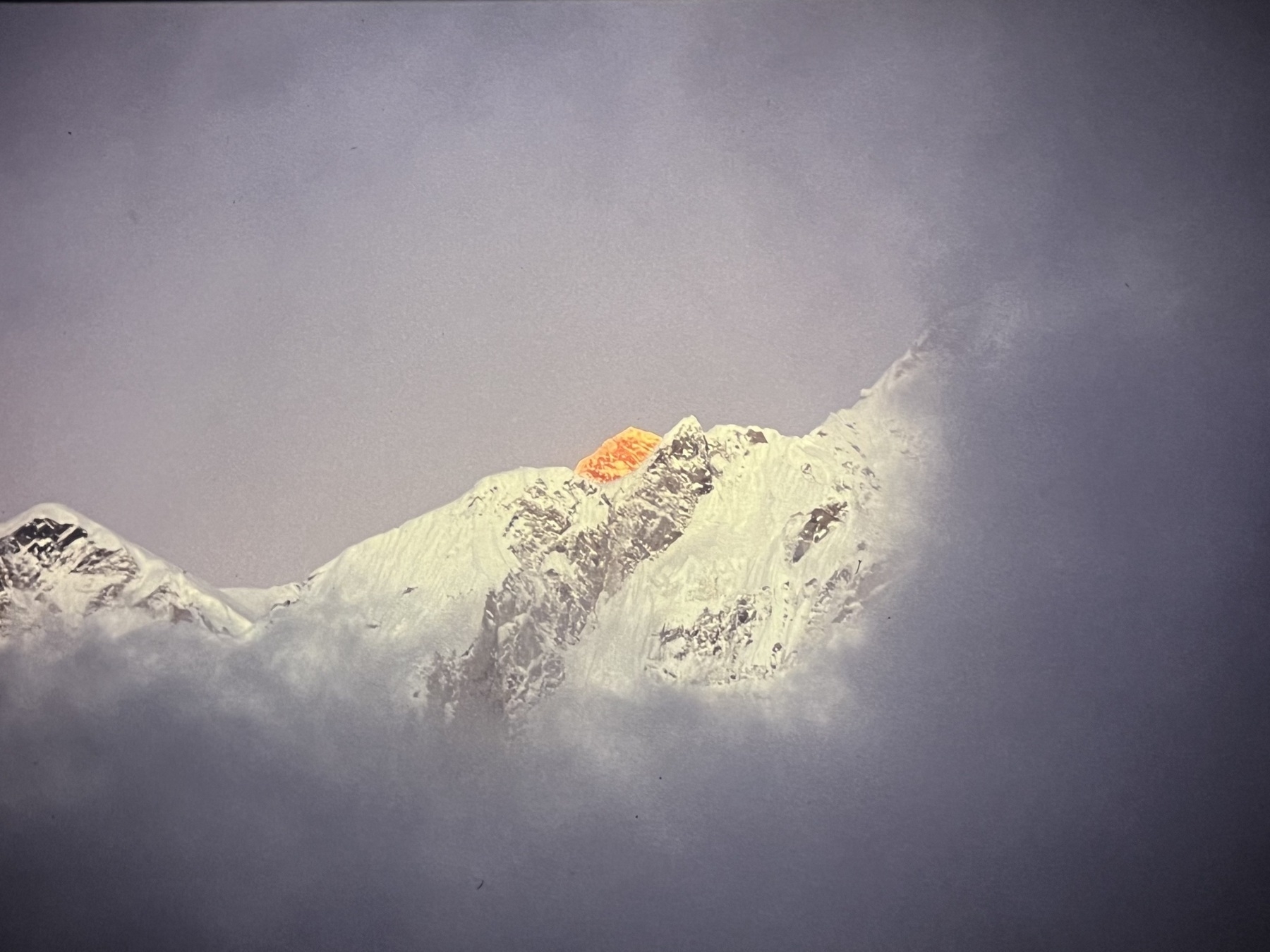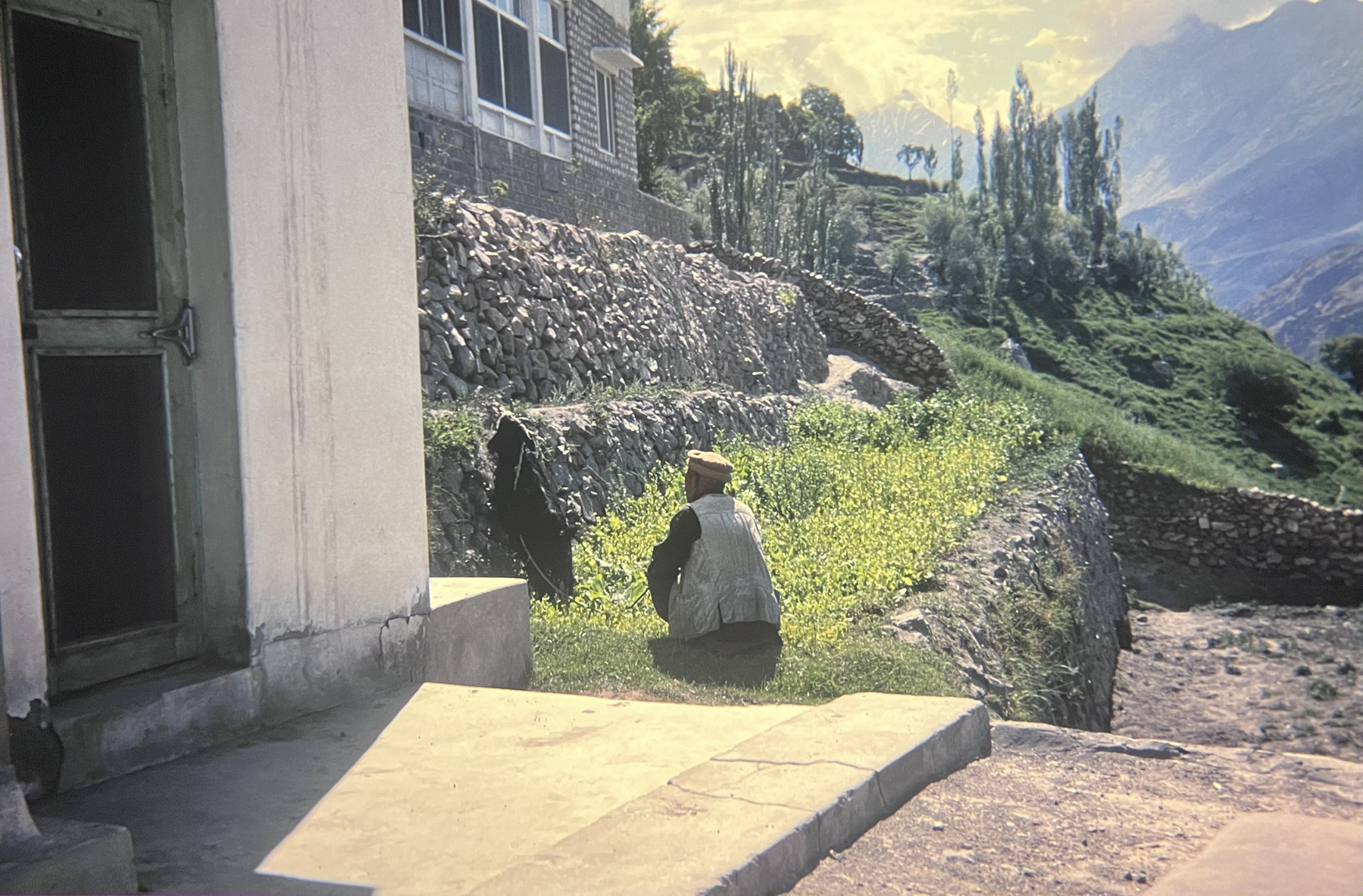OnTheRoad
I feel as though I am pretty tolerant of different toilet facilities that one might encounter in daily life. This is especially so for me while traveling. I’ve used some very basic, very impersonal, very smelly toilet facilities. I’m not saying that I enjoy them or go looking for them, but I find that I can let my guard down and tolerate more.
However none of this stops me from grading my experience and I think the toilet that I used on my flight from Maui to LA yesterday evening was the worst that I can remember. Where do I start…or maybe I shouldn’t?! Discoloured toilet seat, paper littering the floor and something of a questionable nature on some of that paper. Water everywhere. I tipped toed in and shakes off the paper as I walked out. Thankfully only one visit was necessary!
The Story Behind the Photograph: The Taj Mahal
While going through my mixed up and messily catalogued, that is a very generous term, slides, I came across these two images of the Taj Mahal. I am pretty sure that I have some more, but the state of my slide storage means that I am unlikely to come across them in a hurry, chance discoveries aside. So I scanned in what I had found with my rudimentary equipment and am sharing them here.
The year was 1990, the month February. I was on the road, exploring. I set off from home with a strong urge to see the the Karakoram and Himalayan mountains, and Central Asia as well. Something else was pulling me to the subcontinent. I was not sure what, but the pull was strong and I knew that I had to make this trip.
I had destinations and I also had time. Not unlimited time, but enough to allow myself the flexibility to explore as my nose took me. About six months into the trip I found myself in India. I had no plans for India. I can’t even remember if India was on my itinerary when I left home? As I traveled through this year away my interest in Tibetan Buddhism deepened. Such did not exist at all before I left. My travels introduced me to something sitting deep inside, uncovered it for me, revealing why I had left home. Perhaps I shall say more in a later post?
So I had wandered down to India in no small part because India is the birth place of Gautama Buddha, the historical Buddha. During my time there I visited pilgrimage places connected with the Buddhist traditions, and at the same time I had other interests, curiosities….so those curiosities took me to the Taj Mahal.
The Taj Mahal is a mausoleum for the wife of fifth Mughal emperor, Shah Jahan (r. 1628–1658), a symbol of the love he held for his wife, alongside his own immense wealth.
When I found my photos of this famous building, I went back to my journal to see how my time in Agra, where the Taj Mahal is situated, was. I was surprised by what I read. I do remember having some problems there. Being continually hassled to visit marble factories, the Taj Mahal is made out of marble, by people in my hotel, by rickshaw drivers. Those taking me would get a commission whether I buy something or not. I turned down all offers, though finally relented just because I got fed up with the struggle…and actually found the visit quite interesting.
Then there was the Taj Mahal itself. I don’t know what I would think of the building now, but this is what my twenty six year old self had to say,
The Taj Mahal was crowded and I had to queue for tickets. I walked through the entrance to the gardens and there it was. Initial reaction? Smaller and slightly overrated. It was swarming with mostly Indian tourists. I just sat and looked. Basically it’s a white Mausoleum made out of marble and inlaid with semiprecious stones. I walked around it and waited until the sunset. The Taj turned ghostly, appearing from a distance to hang there.
“Smaller and slightly overrated” Hmm? I don’t sound as though I was too impressed? That’s a shame. And smaller than what, I don’t know? Than what I was expecting? I do remember the inlays of semiprecious stones, though. I think that some of the undiscovered slides that I have from my visit includes photos of some of those inlays.
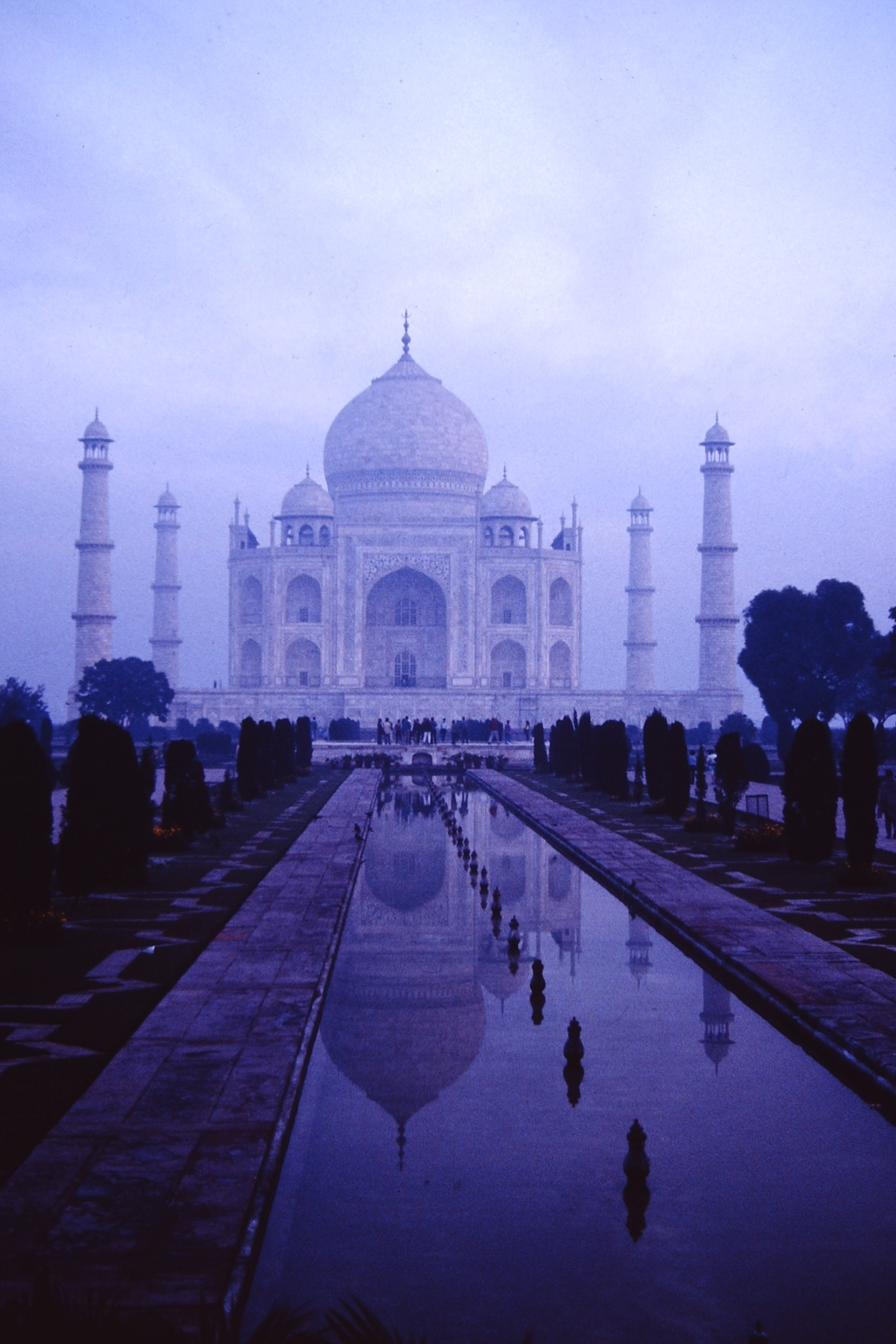
The Taj Mahal early in the morning.

The sun catches the side of the Taj Mahal.
Although I was staying in Agra, the next day I headed out to Fatehpur Sikri, an abandoned yet well preserved Mughal town. Founded as the capital of the Mughal Empire in 1571, by 1610 it was completely deserted.
The following morning, before leaving Agra, I went for an early morning visit to the Taj Mahal to watch the sunrise over the mausoleum. I was joined by an Australian couple. This is what I wrote,
We walked to the Taj, no hassle, and boy was it quiet; the right time to visit it. Again ghostly white in the early morning mist. I went inside. The cooing of the pigeons inside echoed beautifully as did the occasional “la, la” of an Indian obviously there to demonstrate the echo. Dimly lit candles and the early morning sun. I walked around. Yes beautiful, but not worth a trip all the way to India. I still think rather overrated.
Hmm? I still don’t seem to be impressed…that or it was growing on me and I didn’t want to admit it to myself. My perspective might have been affected by the hassle that I received by so many people trying to sell me something? I certainly experienced more of that than I had done anywhere else in the six months I had been away. It was tiring and spoiled the experience of my visit to Agra.
The final photo, more grainy than the others, is the Taj Mahal from a distance with the Yamuna River behind it.
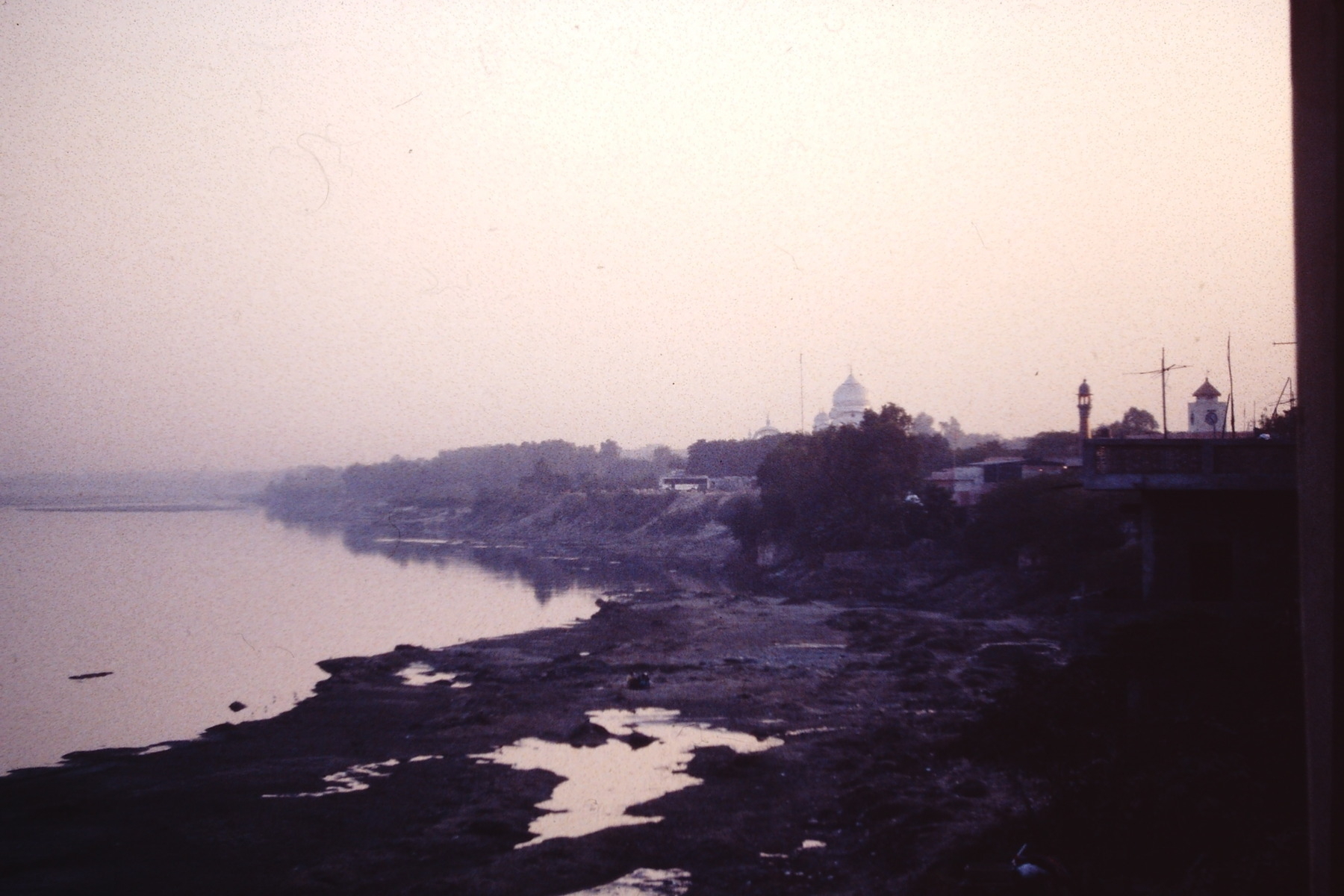
The Taj Mahal peeking above surrounding buildings with the Yammu River behind it.
The Story Behind the Photograph: The Khunjerab Pass
This story started as an exploration of the speed of travel, but I decided that there was a story within that just about my traversing of the Khunjerab Pass. The Pass is closed for a part of the year simply because of snow, it sits at 4,693 meters (15,397 feet), and for the rest of the year is at the whim of politics. I made the journey in 1989, only a few months after the student protests in Tiananmen Square and the subsequent Chinese government crackdown. I would see results of that further into China, but right now sitting in the Pakistan border town of Sust there was no sign that anything was awry. The Pass was open.
The Khunjerab Pass sits on the Karakoram Highway which connects Pakistan with the city of Kashgar in Xingjang Provence. The first part of the journey would take me from Sust to the city of Tashkurgan, close to China’s then border with the USSR. Back in 1989, from my memory, Tashkurgan was not much more than a collection of buildings. The Wikipedia article that I linked to above has a photograph suggesting that it is much larger now. The article also says,
Tashkurgan has a long history as a stop on the Silk Road,
which suggests that my memory is not serving me well here and it might have been larger?
I first became aware of the the Khunjerab Pass through reading the book Danziger’s Travels, by Nick Danziger. A fascinating read if you can get your hands on a copy of the book. It is currently out of print. I decided that this was the way that I wanted to travel into China, through the Karakoram Mountains and Central Asia. For me at that time it felt like one of the last few great adventures, and doing it with local transportation felt like the way to go.
We, a collection of independent international travelers who had met up in Sust, and local people traveling between Sust and Kashgar, made the journey on a colourful Pakistan bus. It would take us two days to get to Kashgar.
At immigration before setting off the border officer gave me a fright, threatening legal action and to send me back down south as my paperwork was apparently not in order. I had heard that it was necessary to register with Pakistan immigration if one was in the country for over a month. On my travels to date I had met a couple of travelers who had registered, but the majority appeared not to have done so, and so not wanting to deal with officialdom where I didn’t have to, I chose not to register. Despite all but one of those in front of me at immigration not having registered, the official asked where my form was and on me replying that I did not have one, asked me why not! He put my passport behind the desk, threatened me with a journey south and got on with processing others in line. I wrote in my journal,
After a few minutes ‘playing’ with me, he gave me the exit stamp and shook my hand, it shook me up.
I remember a grin on his face as well.
With that behind me, I snagged a front seat on the bus hoping to get some good views as we climbed up to the Pass.

Again from my journal,
The road cut its way through a narrow gorge the dirty water, slowly turning crystal clear which it stayed most of the way to Tashkurgan. A couple of stops, army & check post people giving the driver money for alcohol from China. Most of the climbing to the pass was right at the end. The snowy peaks came closer, beautiful peaks complete with untouched virgin snow.The road was effected here more by landslides.
This traveler, and from my memory my fellow travelers were all hoping that the bus would stop once we made it to the summit of the Khunjerab Pass. We were very unsure whether this would happen though, as after all this was just a ‘local’ bus service and not a sightseeing tour. However, after a very steep and vertical climb up to the pass the driver did indeed stop when we reached the border separating Pakistan from China, at the Pass’s summit. Whether that was for the benefit of of the international passengers that he had on board or simply because he wanted to take a rest, I don’t know. Either way, the stop was much appreciated.
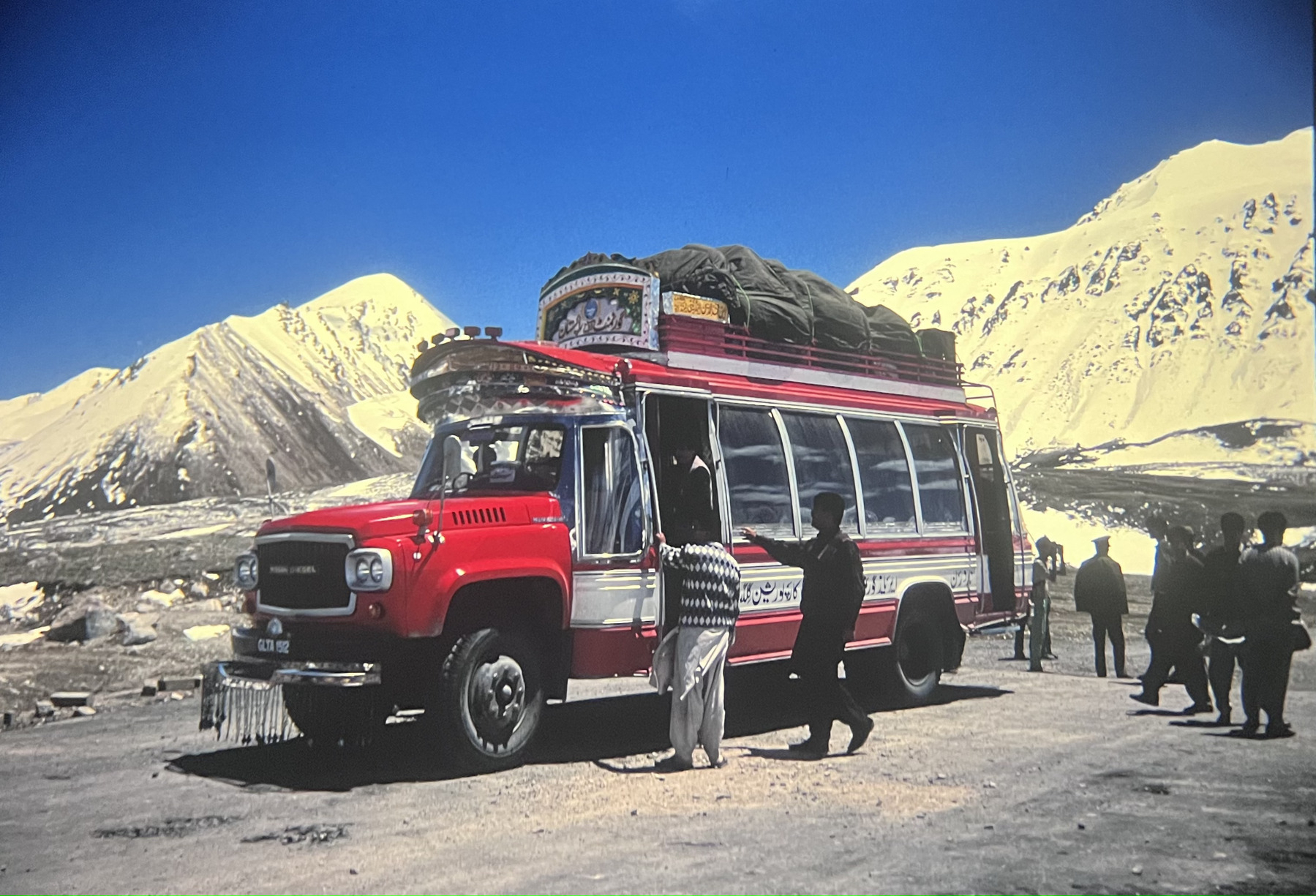
A Pakistan bus parked at the Khunjerab Pass.
I jumped out and played the tourist, elated that I had made it to this remote part of the world. On the edge of central Asia, and so rich in history despite its isolation.
A theme that ran through these travels for me was one of familiarity. I experienced a sense of familiarity with the land that I was traveling through, and a similarly with the peoples whom I encountered. But in that moment of arrival at the Pass, I was just very happy to have crossed into China via this route.

A sign commemorating the opening of the Khunjerab Pass.
From my journal,
The Khunjerab Pass was a plateau on which a couple of posts and guards were based. A green plain. We went crazy, acting the tourist, arm around a Chinese guard. I’d arrived and felt great.
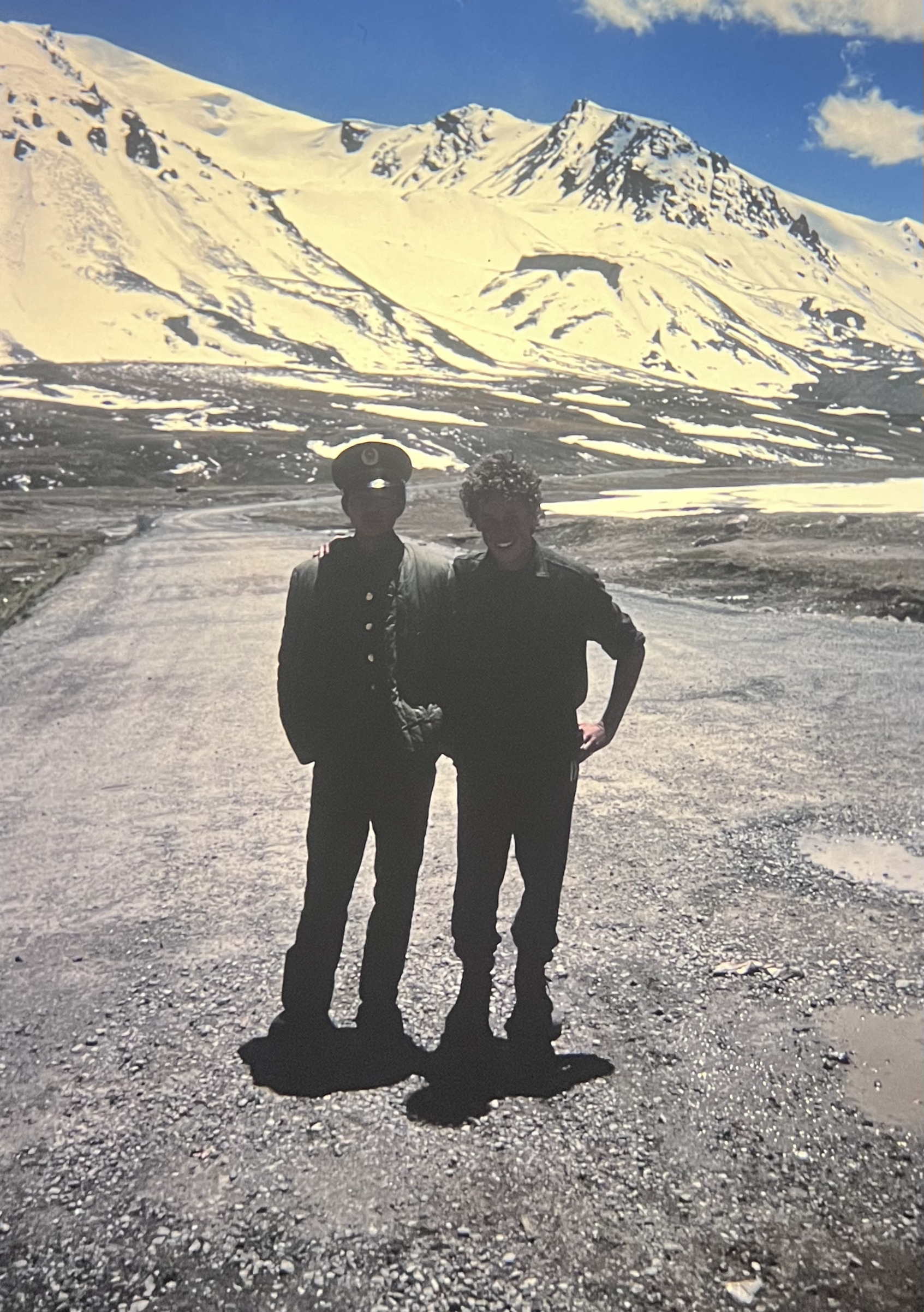
My arms around a Chinese guard at the Khunjerab Pass. I’m not sure he was as happy as me?
There was little there to mark the border apart from a couple of signs. I felt for the couple of Chinese guards positioned here, the isolation. Pakistani personal had got off lightly…there was no one from Pakistan positioned there. Nowadays, as this image from Wikipedia suggests, the border is a lot more obvious, and I assume that there are more substantial buildings around it? I was now at the highest point that I had ever visited, 4,693m (15,397ft), although I would break my own record later on in the trip.
Once back on the bus and moving again we started the journey down to Chinese immigration. We lost height quickly on leaving the pass. The road started off poor, I would guess due to the weather conditions at the pass, but soon after improved and was excellent from then on. Again, let me share from my journal,
Chinese workers were out here, in a beautiful wilderness in the back of beyond. The road dropped down onto an open plain of brown surrounded by mountains. At Pireli, Chinese immigration, we sailed through officialdom and waited a long time for the buses to load up and leave.
I mentioned this place Pireli in my journal, but can find no mention of it now online or on maps? Maybe it was a temporary immigration post that has now been reassigned somewhere else? However, I do remember a long wait there before we boarded the Chinese buses to Tashkurgan. My guess is that the Pakistan bus returned to Pakistan having picked up travelers departing China. It must have got back to Sust quite late, unless the bus hung around for a morning departure?

Waiting by the side of the road at the Chinese Immigration town of Pireli.
Sitting, waiting,I reflected on where we were. The stamp in my passport said China, but this was not an ethnic Chinese area. The peoples here are Uyghurs. Not too far away, over the mountains was not only Pakistan but also Afghanistan. With this being 1989 the Soviet Union was north of Afghanistan, surrounding Xingjang Province of China to the north east. Today the countries of Tajikistan, Kyrgyzstan and to the north of that Kazakhstan have replaced the USSR to border the province. These countries' presence did not diminish the impression of vastness that this part of Central Asia left on me, indeed their presence possibly added to that sense. Sitting there waiting for the bus allowed me time to take in the expanse and isolation of where we were. That and this sense of familiarity.
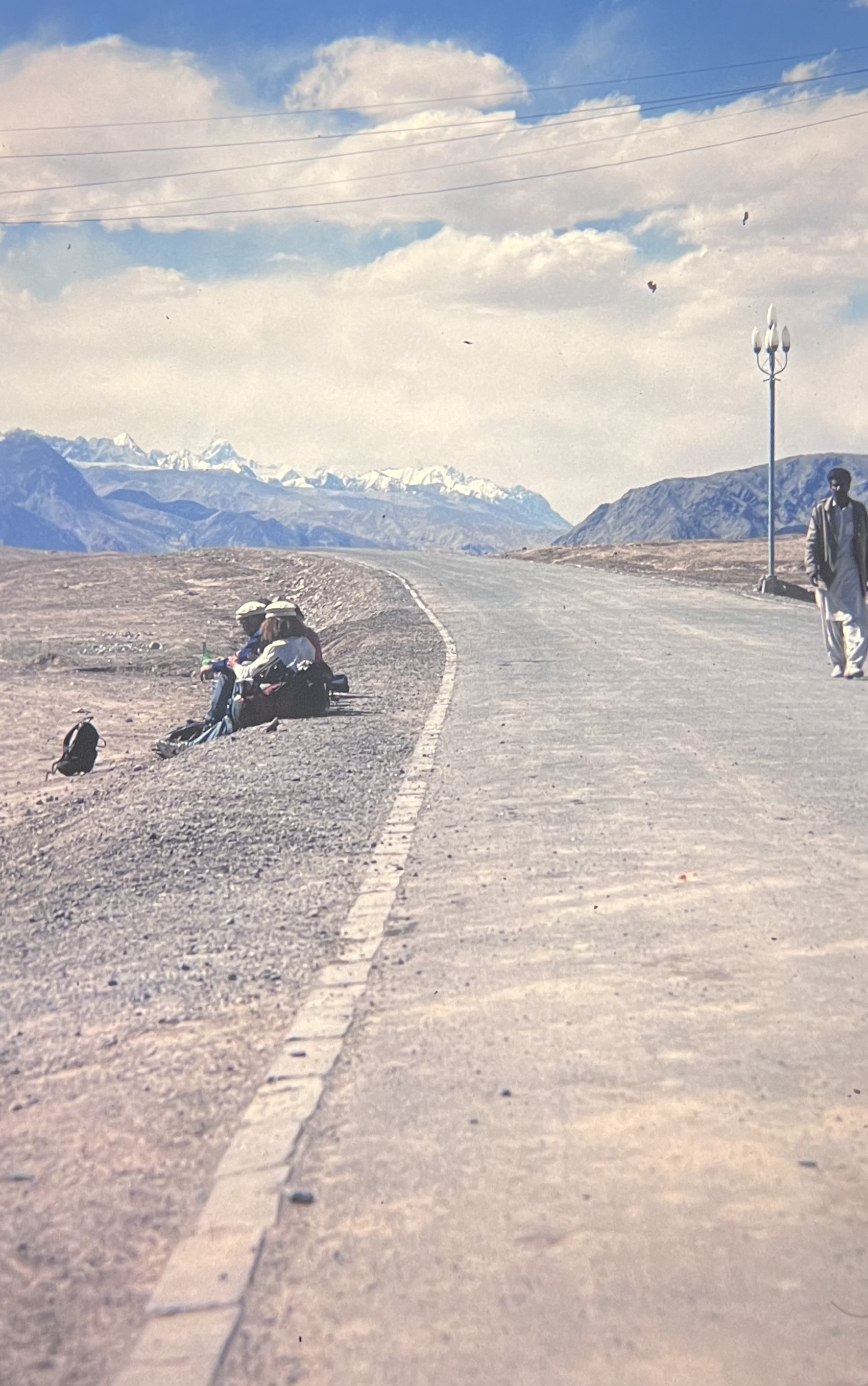
A group of travelers sitting by the road in remote Xingjang Province, waiting for a bus.
Images of the Road
I have long loved rail travel. Sitting in a carriage, watching life go by. Gratefully allowing others to take the strain of the transportation logistics. Perhaps striking up conversation with a fellow traveler, or more likely than not sitting quietly reading, writing, watching, sleeping.
When I got older and threw a backpack on my back railway stations took on another significance for me. That of unknown adventure. Yes, I might have had a ticket in my hand stating an intended destination, but as I looked out at the train tracks disappearing into the distance from the station platform I had a sense of unknown adventure ahead. I really don’t know what would happen next?
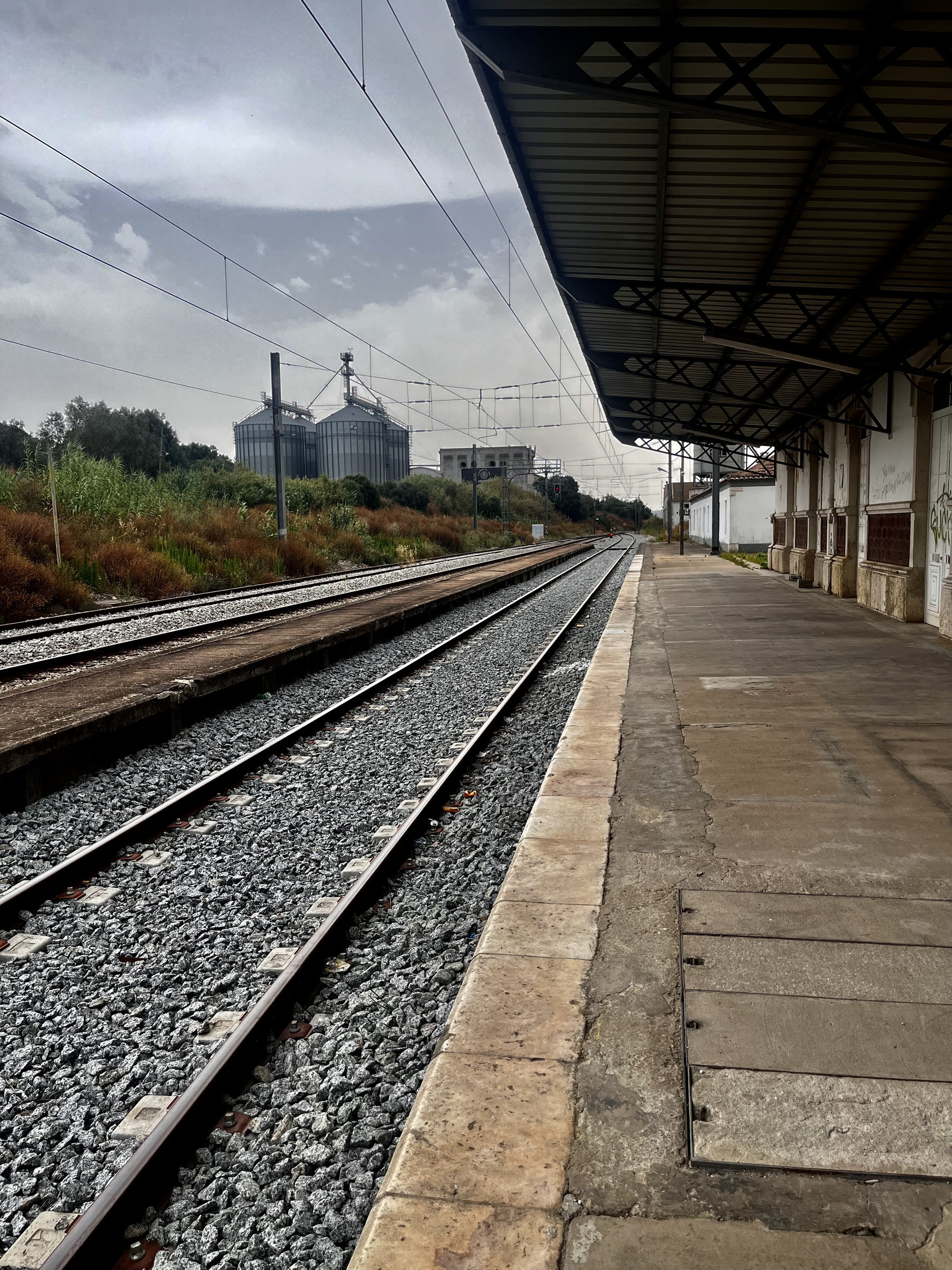
Alcácer do Sal Railway Station
Yesterday my wife and I went to meet someone at Alcácer do Sal Railway Station. Sadly trains no longer stop there. Although a decision made many years ago, I still hold hope that that conclusion will be reversed.
The person who we were due to meet was not there - it turned out that he was on a train heading south. This did not matter to me. The railway station is a beautiful old building, even if it is becoming covered in graffiti. Standing on the platform looking out at the tracks fading into the distance took me back to life on the road. Images of myself waiting for my train seated on station seat, seated on my backpack, looking for a bite to eat, or simply standing. What lay ahead? I knew and I didn’t. A known destination, but unknown experiences. Just the journey to the next port of call became an adventure. And with that there came a sense of freedom. A letting go into what lay ahead.
This was the closest to me ever living a homeless life. I was far from homeless - I could always find myself somewhere to stay at night, and a ticket home as a last resort would have always been an option (though I never considered it) - but in that moment of being on the road, just me and what I had on my back, I was at the whim of what I encountered. And with that came a release, a sense of stepping into the unknown and letting the unknown be the journey.
I gained the same sense, perhaps even more so, when I was standing by the road hitchhiking. As with the train travel the destination was known, but this time even the ride was an unknown entity - who would pick me up, how far would they take me, would I reach my destination that day, the next day or find myself heading off somewhere unknown to me in that moment?
I miss those journeys though cherish their memories, and at times I sense that that is also my life now. I have plans now for the days, weeks, months ahead, but with what degree of certainty do I really know what will happen in the next moment? Am I always standing on station platform?
The Story Behind The Photograph: Two Boys Playing Cricket
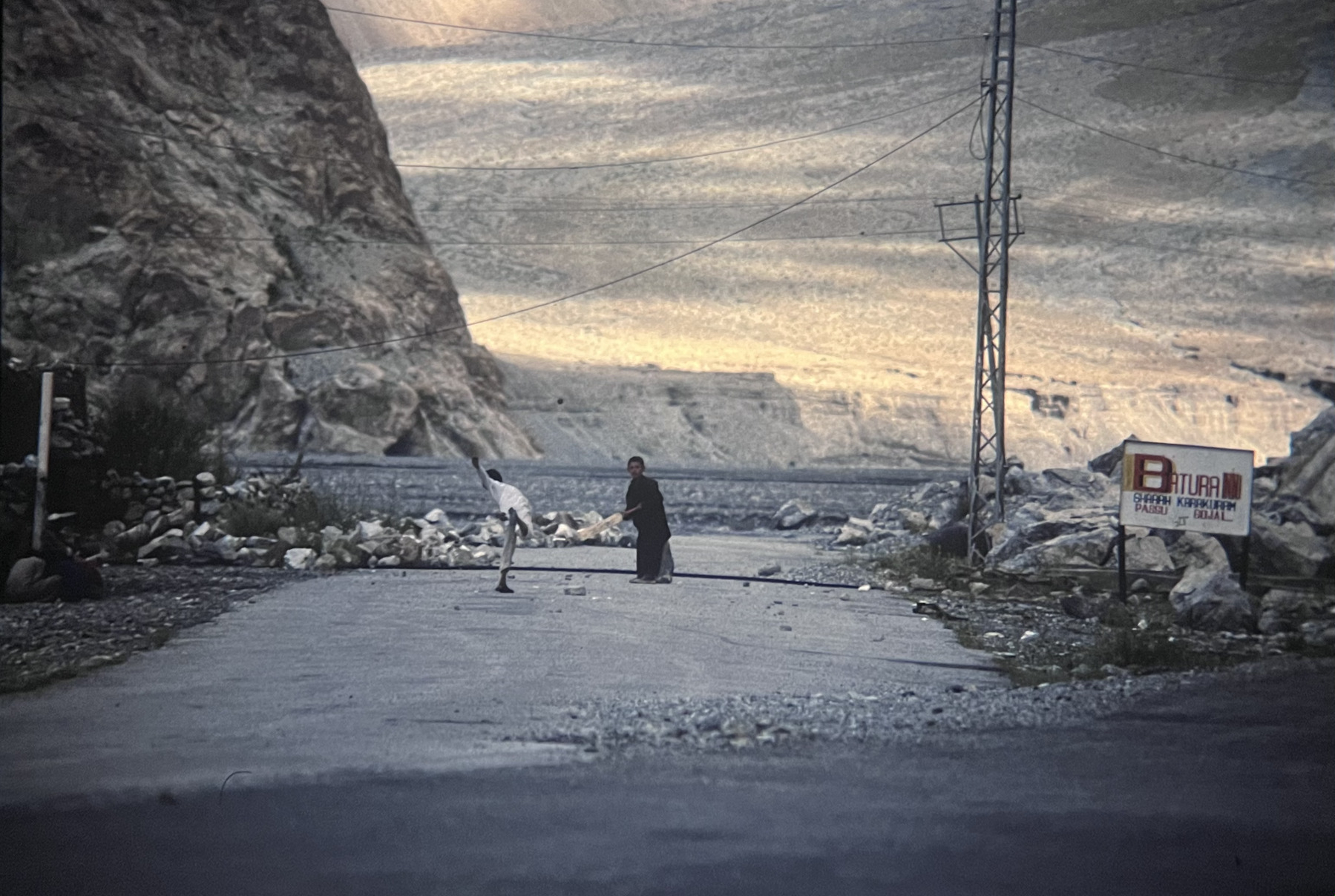
Two boys playing cricket just off the Karakoram Highway
While traveling the Karakoram Highway through Pakistan I stopped in Passu for three nights. My memory of Passu in July of 1989 was it just being made up of a small collection of houses. Nothing else. One of those was the guest house that I stayed in. This was run by a lovely man who use to be in the Pakistan army. Because of his military career, and despite what the isolation of his guest house might suggest, he had a good knowledge of the world outside of the mountains where he now lived. I remember his son playing with a pen knife that I was carrying and asking how much it cost? I mentally converted the UK Sterling price to Pakistan Rupees, and told the young boy. The price would have seemed ridiculous in that small isolated world, and he could not believe what I just shared. His father gave me a knowing nod.
Passu was near to the tongue of the both the Passu and Batura Glaciers. Surrounded by the peaks of the Karakoram mountains, I found it a spectacular place to immerse myself in the wildness of nature. The scale of all that surround me gave one a sense of insignificance. Traffic on the highway was next to nothing, allowing the safe space for these two boys to play a game of cricket just a cricket ball’s throw from the road.

Mountain peaks over looking Passu
I write this remembering overcast days. Fresh clean, clear air allowing a clarity of thought. And the high mountain peaks, alongside the air quality and ruggedness of the terrain, all reminding me that I was near the roof of the world.
In Odeceixe
We visited the town of Odeceixe just over a week ago. I was tasked with finding the destination for the day, somewhere where we had not visited and not far or on the coast. So I picked Odeceixe at random.
At first glance there appeared nothing special or unique about the town. When we arrived it seemed very quiet. Situated about 3km from the coast there were few people around. We skirted the edge of town, and after two hours of driving I parked by what looked like some fields on one side which stretched to the coast, although out of view. To the other side was a small town square with statues of people walking and bicycling. At that moment these metallic statues seemed a little incongruous. I could see some similar statues in the distance. The air was quiet and peaceful. I appreciated being there.
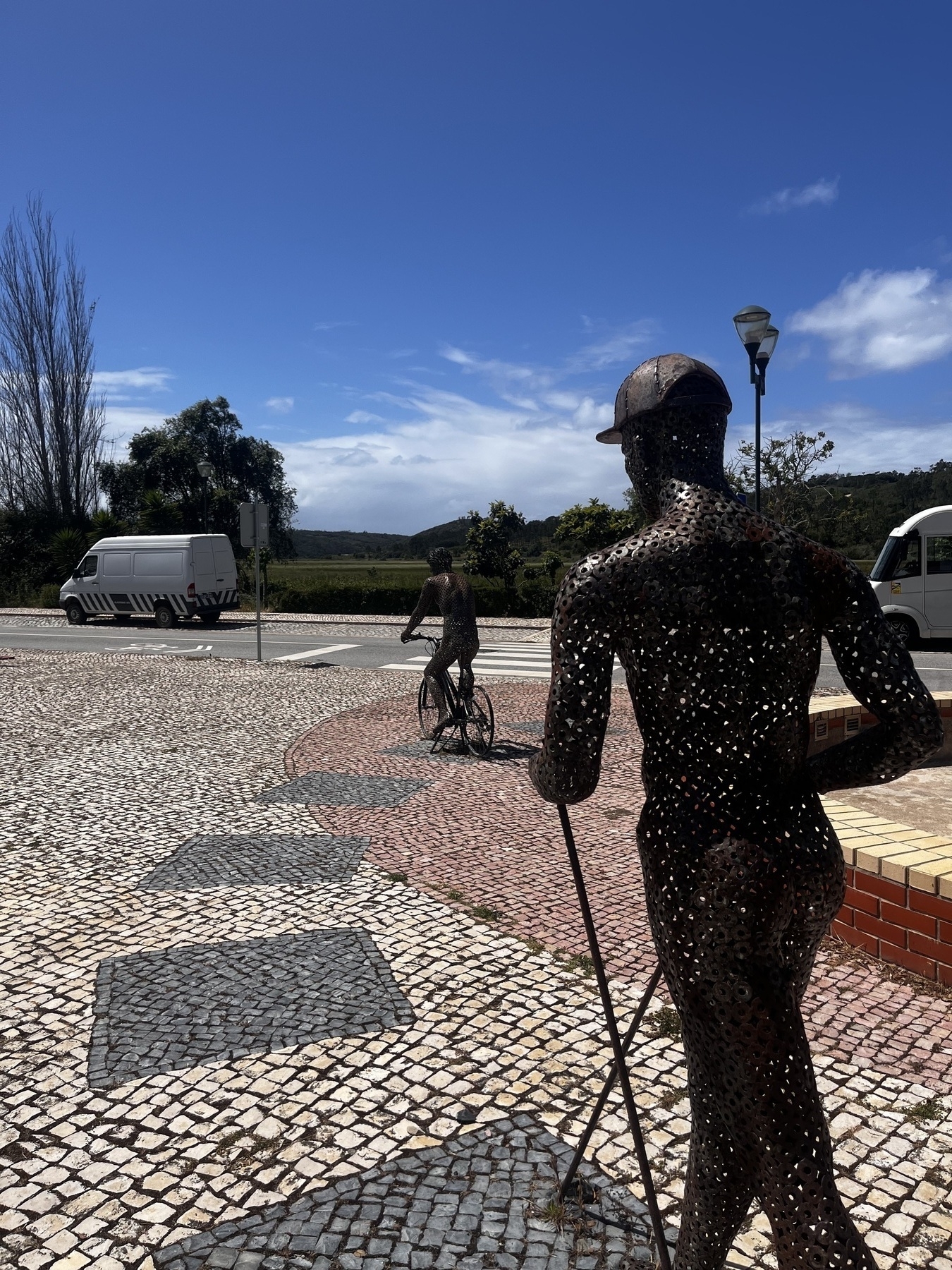
Feeling hungry and not really wanting to drive too much further we decided to head to the coast on the hope of finding a bite to eat. A narrow road, also designated as a cycle path, took us there. As we started off, we noticed walkers hiking across the fields. We passed more on the road.
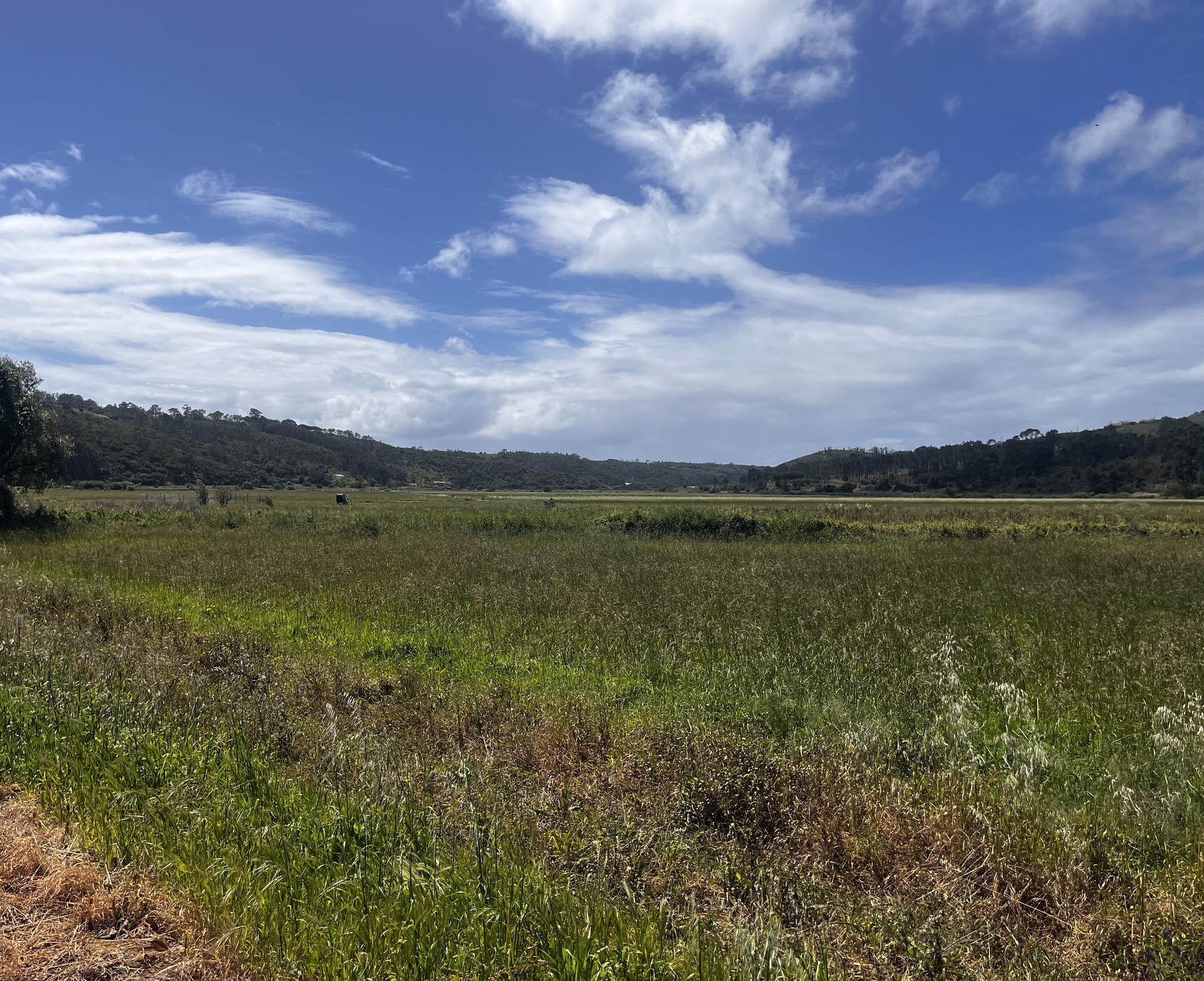
The road twisted and wound round the low hills that bounded a grassy field. I imagine that this was either a carved river valley, a small river could be seen, or this was an ancient glacial ravine? We finally arrived at a small collection of houses situated at the top of cliffs above the Atlantic ocean. Happily some of those buildings served food. We found a place to park the car and got out to walk round to one of the cafés. There was bright sun light and a bracing wind. The road and path cut round the top of the cliffs back to the small habitation, giving a clear view to the beach below with the Atlantic waves breaking on it.
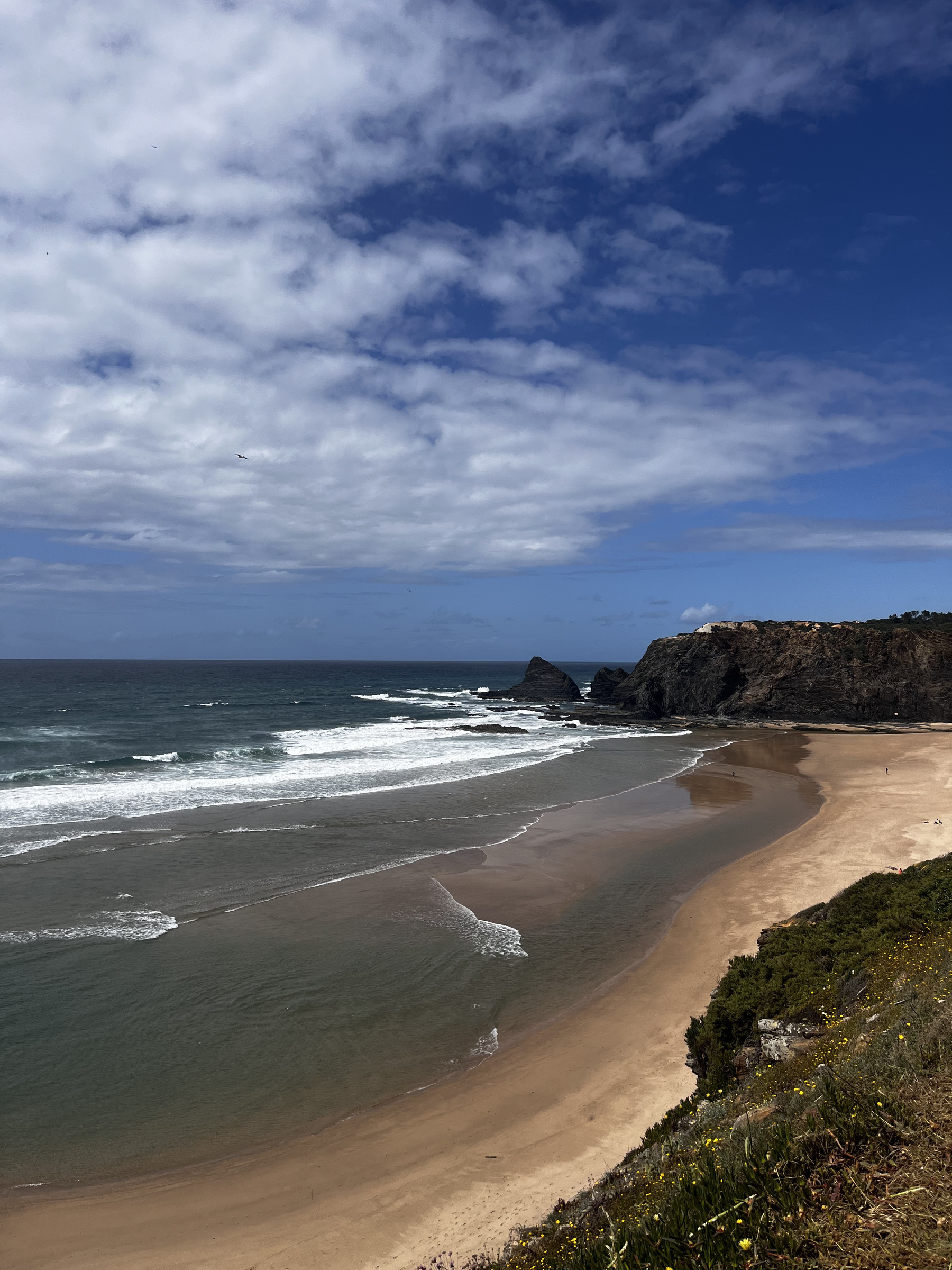
We found a place to eat, outside but out of the wind. While we ate hikers continued to show up. These were not just casual walkers. They had proper hiking boots on, backpacks and hiking poles. They were here for a good walk, not a casual amble.
Warm and replenished, we walked back to the car and drove slowly back the way we came to Odeceixe. Again on the way we passed more people hiking. Odeceixe appears to be known as a place for serious walkers to come to…them and I guess cyclists as well going by the metal statues.
I enjoyed our short time in Odeceixe and could have stayed longer. It is one of those places that doesn’t appear to get any mention in books about the area, but for that day it felt like I had stumbled across a hidden gem. Nothing special necessarily. Nothing that cannot be seen elsewhere. But for that day Odeceixe left an impression on me. It reminds me of other slightly out of the way places, at least out of the way to those who don’t know of them, that I have come across while traveling. I don’t know if I will, but I’d like to return.
The Story Behind the Photograph: The Details
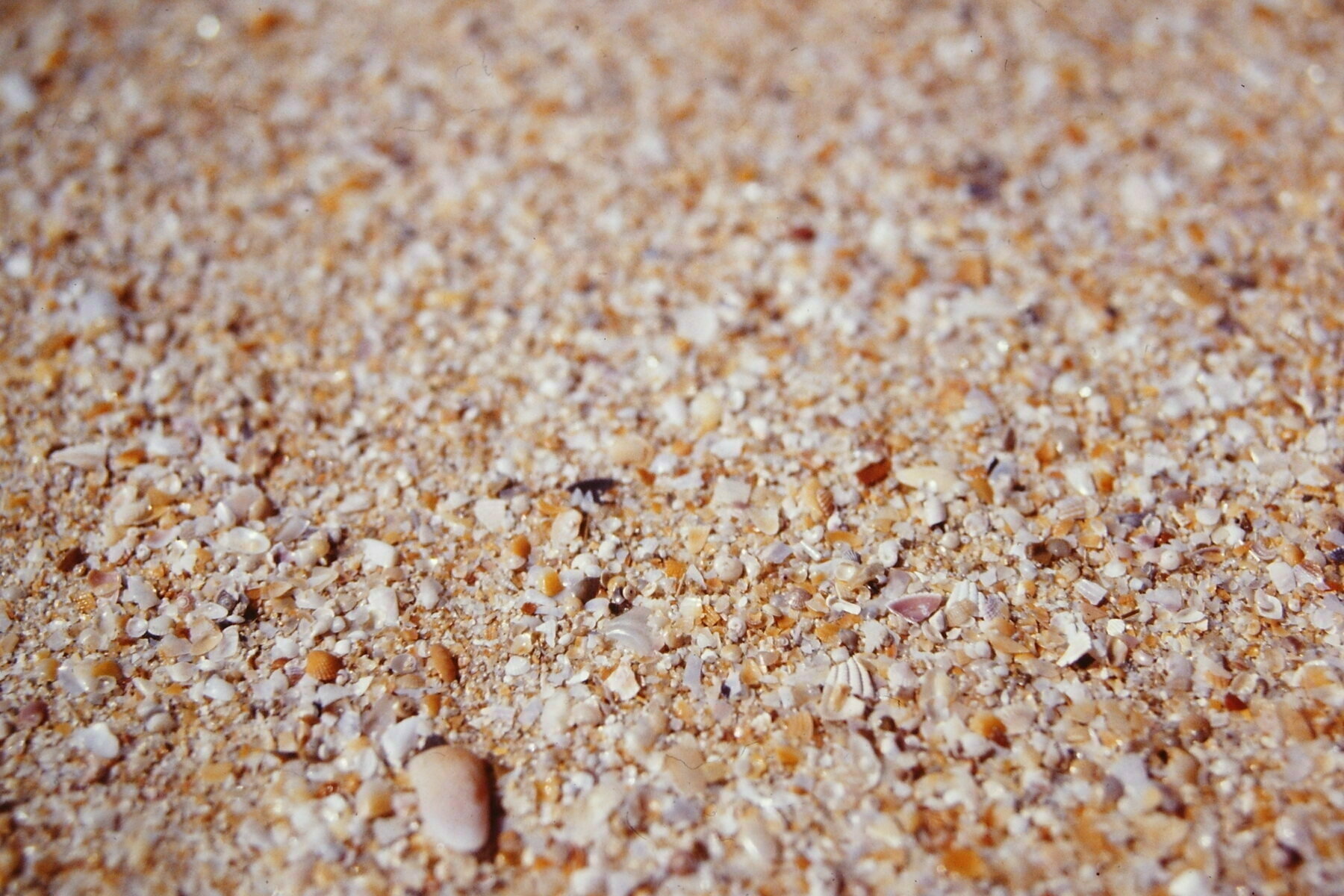
Close up of a beach.
This is a short story. As I go back through the slides of my travels, I am interested in what caught my eye. What I was seeing while I was on the road. One way I look at this is what my heart was drawn to, what interested me, what moved me.
This slide could be from anywhere, at least from any beach in the world. On that level there is nothing special about the image. In actual fact this particular beach is Benaulim Beach in the state of Goa, India. My interest in this photograph was that I took the picture in 1990.
Thirty years later in 2019 and in 2021 not once, but twice I got down to see what was under my feet…at least those were the times that I recorded doing so.
Going back further, in my childhood I remember sitting in the cradle of the roots of a Beach tree at the bottom of our garden and just watching what was going on around me. Behind me was the strong support of the tree. Beneath me the softness of the grass. I’d gaze down through the grass, being observant to the smaller world beneath me.
During my years living in Wales I spent a considerable time just being in the area where I lived. I became very intimate with the land around me. I started to notice the small details in the land. Hearing and seeing the happenings around me. The land really did feel like home. The neighbours were the critters who lived around me. I think of the poet, essayist and Buddhist Gary Snyder speaking on the subject of getting to know your neighbours,
I consider it a form of good manners. It’s a kind of etiquette. It’s not just that you should get to know your human neighbors, but you should get to know all your other neighbors as well. Etiquette involves being able to say hello in an intelligent way to a tree, to greet a bird. And that means you ought to at least know its name. ~ Inquiring Mind, Spring 2012
It’s the details, the small things that interest me.
I find that this can manifest in other ways. When I was hitchhiking through Australia and New Zealand I would find myself getting dropped off in many out of the way places, far from my final destination. My ride was turning off my route and so would leave me in a small town, or sometimes in the middle of nowhere. This could especially happen in Australia where the distances are so great. Those places would become important to me. Points on a map, the old style, fold out maps where I could it a pin and say, “I visited there. I stopped off there.” However, now there I had to decide what to do next - move on, stay put? I might be there for a few hours or overnight, choosing to camp when it started to get too late to wait for a ride. I remember in North Western Australia spending twenty four hours trying to hitch out of the town of Halls Creek. The lack of traffic played a big part in that long wait. Part of my time by the side of the road was spent talking to a local Aboriginal person. Earlier on in that trip, in the south east of the country I was offered some advice and a cold beer.
Those out of the way drop offs felt like joining the dots between the big destinations.If I found myself in a small town that I might otherwise have shot through on my way elsewhere, I was interested in why this habitation was there? What caused people to settle there? What do locals do in this place? What’s going on? What’s the “why” of the place?
So returning to the photograph at the top of this piece. I’ve been blessed with having visited a number of places in this world so far in my life and through them all I still see this theme from when I was young, of looking for the smaller details. Indeed sometimes chasing after the bigger picture just feels just too much at times. It overwhelms me.
Perhaps I had more to say on this photograph than I thought? Details are, I suppose…detailed.
Before I go, let me ask you…what’s happening beneath your feet?
Mountains, Rain, and Pat Metheny
I sit here in 2024 in a house in Portugal, and a piece of music transports me back to 1985, to a hiking hut somewhere in mountains of the Southern Alps of New Zealand. Almost forty years have passed, but the memory is vivid and the effect of that time on my life feels as real now as it did all the way back then.
Let me give you some context. I had left England with what was then called a Working Holiday Visa for Australia. My flight to Australia took me via New Zealand. I had planned on visiting an old friend of my mother’s, spending a brief two weeks looking around part of the country, and then flying up to Australia. A month or so later I found myself in this hut down in the south of the South Island of New Zealand, at the end of a very wet day. In total I spent three months hitchhiking and walking my way around the country.
So here I am sitting in a hut on the Routeburn trail, a hiking trail in southern New Zealand. I’m thinking that it was May/June time, mid-winter. I don’t have my journal for that trip with me right now and so can’t be sure on the month, but I do know that it was winter. Thankfully it was a mild winter thus far and so the mountain passes were open. However, it was winter and outside the hut it was dark and a storm had been going strong since early in the day.
We, three of us who had met in a hostel a couple of days beforehand with shared intent to walk the Routeburn trail, had hiked the whole afternoon through rain and flooded rivers. Even the emergency paths, so created incase the rivers flooded, were ankle deep in water. We were soaked to the skin with waterproofs not proving to be so waterproof in such conditions. Our packs were drenched and by default so was everything in them, clothing, sleeping bags and food. The firewood outside the hut was sodden, making the rather miserable prospect of a cold night with no means to dry anything. Luckily there was a bit of wood left inside the hut to get the fire going. With that eventually lit and some food warmed and eaten, we decided to do shifts through the night to keep the fire burning. That way we could give our belongings, hanging from lines strung around the hut, half a chance to dry - who were we kidding? We were the only people in the hut, indeed as far as we knew, the only ones on the trail. After all, who in their right mind would have set off to hike in weather like this? Not only would one get soaked, but there would be no views except what was right in front of your nose.
The time came for my shift and to sit by the fire, encouraging it to stay alive and offer us and our clothes a modicum of warmth. I had my Sony Walkman on and was listening to a cassette of Pat Metheny’s album Works. I had picked up the cassette somewhere along the road, though I have no idea what had made me buy this particular music? Pay Metheny, a jazz guitarist and multi Grammy award winner, was definitely not an artist who I had listened to before. However, that night as I tended to and nursed the fire, as the wind howled and the rain poured outside, I sat listening to Works, a collection of Metheny’s music.
It was the album’s fifth track which really hit me. As the opening notes of It’s For You came on, I felt transformed, ecstatic. The music lifted me. I was listening to the music and to the storm outside, to the rivers flowing, the waterfalls, the wind whistling through the trees. I was listening to it all at once, the music seeming to be a perfect fit for all that was around me. I was there in the hut, alone as my fellow hikers slept, and at the same time present with everything. I was so aware of our remoteness. That out there somewhere the world was going about its business, and here we were, here I was high in the mountains, the location accentuated by the weather which seemed to strip away any bravado, bringing everything down to essentials.
In that moment the weather conditions felt like my best friend. I was where I wanted to be and knew in a way what I also didn’t know….all that I wanted to do with my life. That I was at home in the openness of possibilities and certainly in that moment, the road.
April Photoblogging Challenge, Day 20: Ice suggested by @the
This photograph shows the terminus of the Batura Glacier in the Karakorum mountains of Pakistan. It sits at around 4,000m (13,123ft), and at the time that I visited the glacier terminated 0.5km from the Karakoram Highway.
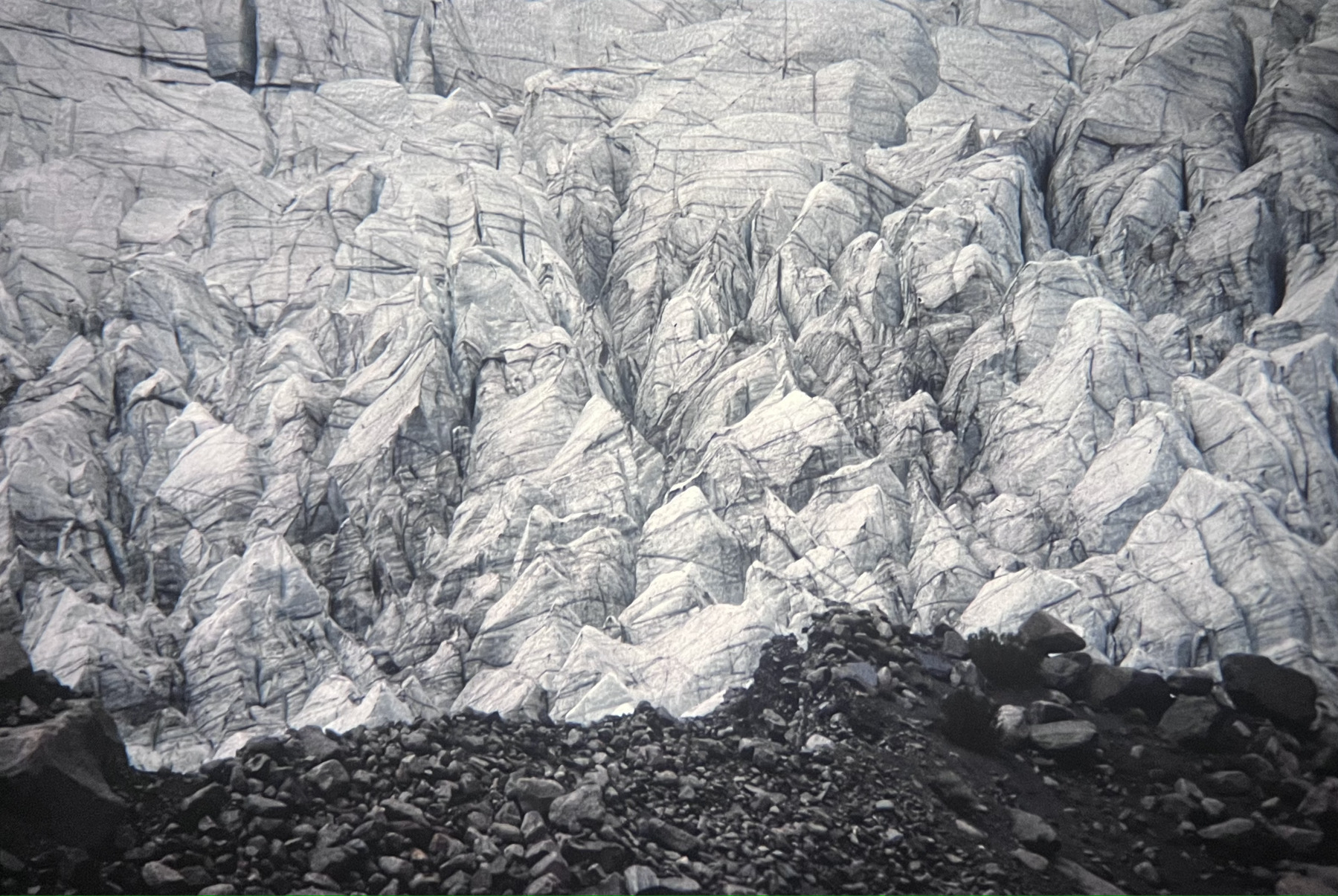
Experimenting with a Different Way to Capture the Travel Slides
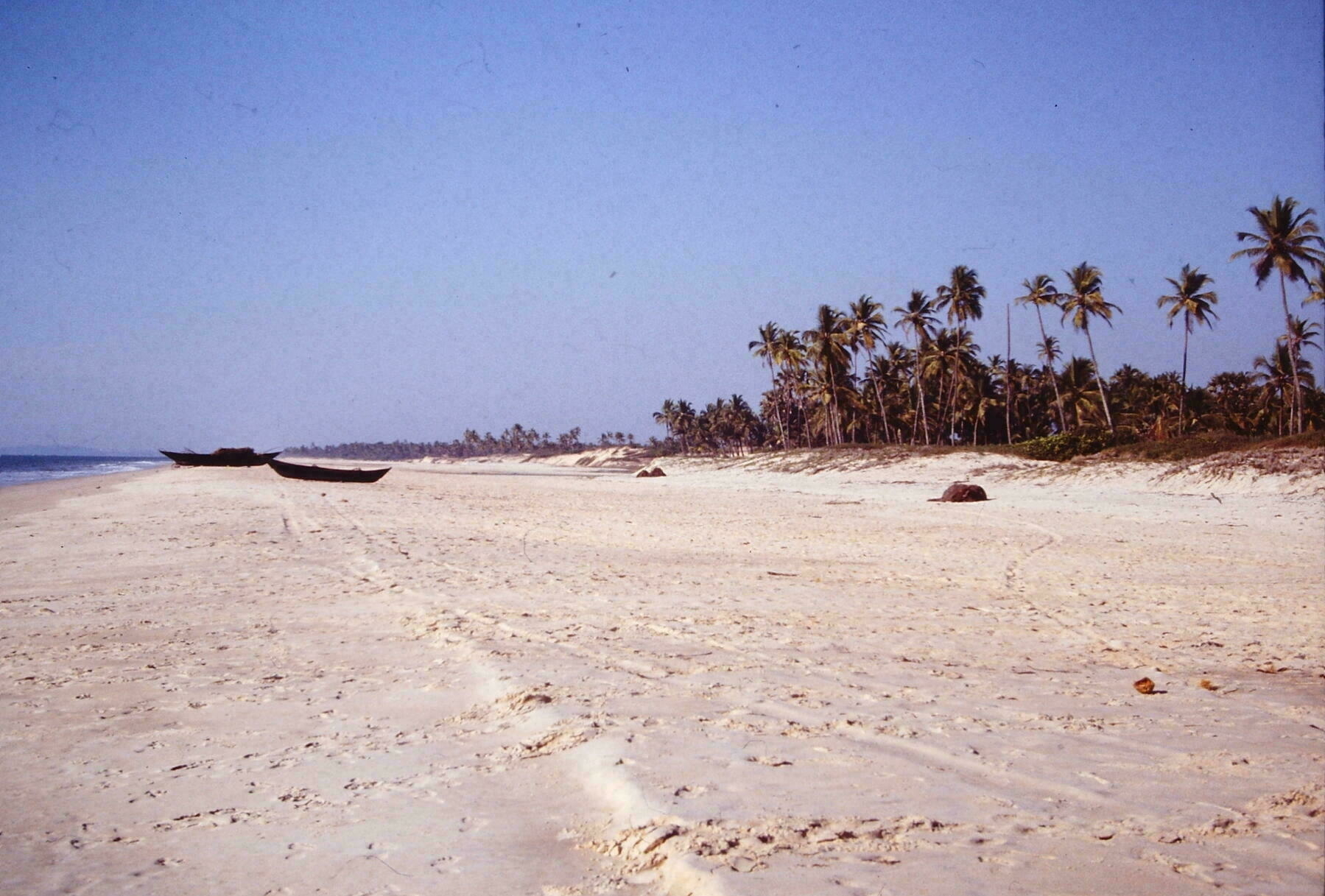
Benaulim Beach, Goa, India.
A month ago I explained how I was capturing the slides that I am using in the “Story behind the Photograph” series (all of which can be found here (RSS), or under the map emoji 🗺️ in the menu bar above). Well I have now found a gadget that I was given a number of years ago. Its purpose is to digitize slides and negatives. Due to the device’s age, the scans are probably not the best. With the slides also being about thirty years old, the resultant images have a vintage look to them. Possibly the original method, which includes the use of a modern day iPhone camera, is producing better images? Either way, I am going to continue experimenting with this little gadget and see if I can do any fiddling with the images to improve them, without at the same time loosing the authenticity of the original.
My reason for doing so is because this method allows me to digitize the slides so much quicker, and I do not have to wait until nightfall for it to be dark enough to use a projector to view the slides. The slides themselves are still in a complete jumble, and so finding groups of photos centered around one part of the trip, one story, is not always easy whichever method I use.
The Story Behind This Photograph
The photograph above is of Benaulim Beach in Goa, India. I have not altered this image from the scan that I made with the little device. The photo was taken about two weeks into the new year of 1990.This image pretty much summed up how busy the beach was, and it was a very long stretch of beach. Once I got past the village of Benaulim and the fishing boats, there was no one there. My memory is that the beach went on and on until it came to the mouth of a river right at the end. Apple Maps confirms this, though it does not give the river a name.
As I walked the length of the beach I saw the beginnings of construction of what looked like resorts and hotels. Goa now has an international airport, and so I do not know what this beach looks like today? My hope that its shear size swallows up any development.

A village hidden beneath palm trees.
On arrival had no plans for how long I would stay there. I had a room in a house that I shared with another traveler; what might be called at 1990s AirBnB. The house was in a small village and only fifteen minutes walk from the beach.
At that stage I had been on the road for seven months. The relaxing atmosphere of this part of Goa ate into my bones and I ended up staying there for a week. I walked, read, met people (both local and travelers) to sit and talk to. It was just what I needed at that time.

Sunset over the Arabian Sea.
The Story Behind the Photograph: Fellow Travelers in Northern Pakistan
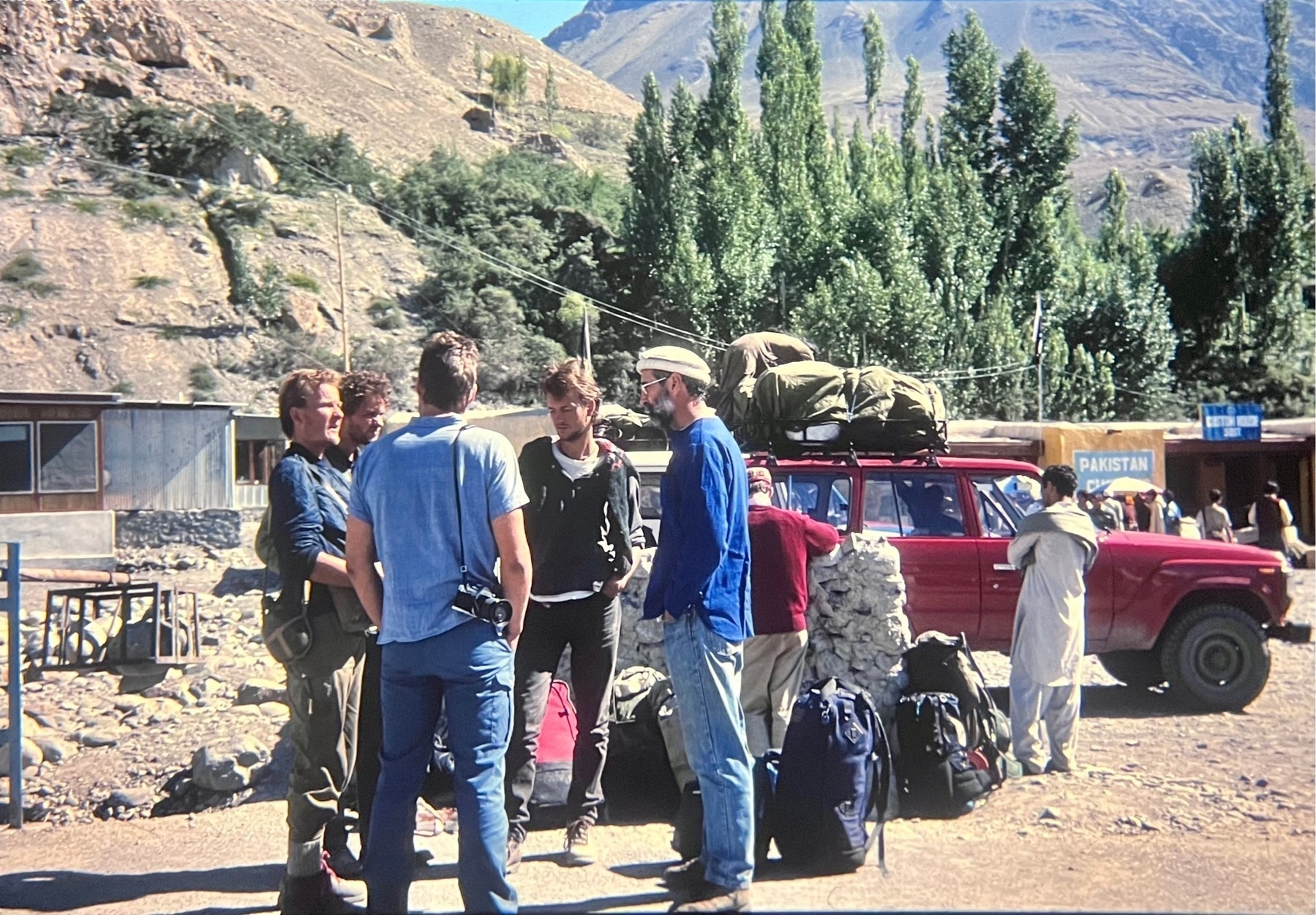
Waiting at the border crossing
I was going through some more slides of my travels last night and this one has stuck with me through the day. Taken in July 1989, I recognized most of the faces, as well as the nationalities of some of those standing there, but could not put names to them. I found myself wondering where they are now? What happened to them after we parted ways on our respective travels?
The photo was taken in Sust, the border post on the Pakistan side of the Karakoram Highway. I had arrived there the day before, too late to clear customs and immigration and catch the bus onto Xinjang Provence in China. The drive up from Sust, which is already 2,800 meters (9,186 feet) above sea level, to the Kunjerab Pass at 4,693 meters (15,397 feet) takes a few hours from my memory, and I think that there was only one bus a day. Once up to the pass there was another hour or so to the Chinese border post, where everyone spent the night before driving onto Kashgar the next day. But I’ll save that story for another post.
So this mixture of backpackers from around the world found themselves in Sust for the night. I think that this photo was taken either while we were waiting for customs and immigration to open - a couple of tables sitting outside, again from my memory - or we had passed through them and we were waiting for the bus.
When I come across images like this with people in, whether people who I’ve interacted with or simply people who have made it into a photo that I took, I wonder what has happened to them in the intervening years? Where did their life take them?
For a few days I traveled with some of those in this group, and then our paths forked as we headed off on our separate ways. I would then travel alone for a short time until after a few days I’d meet up with someone else. I wonder what life brought this group of travelers?
The Story Behind the Photograph: In Bodhgaya (Part 1)
A lot happened during my short time in Bodhgaya, and so I am spreading this section of the travels over a couple of posts.
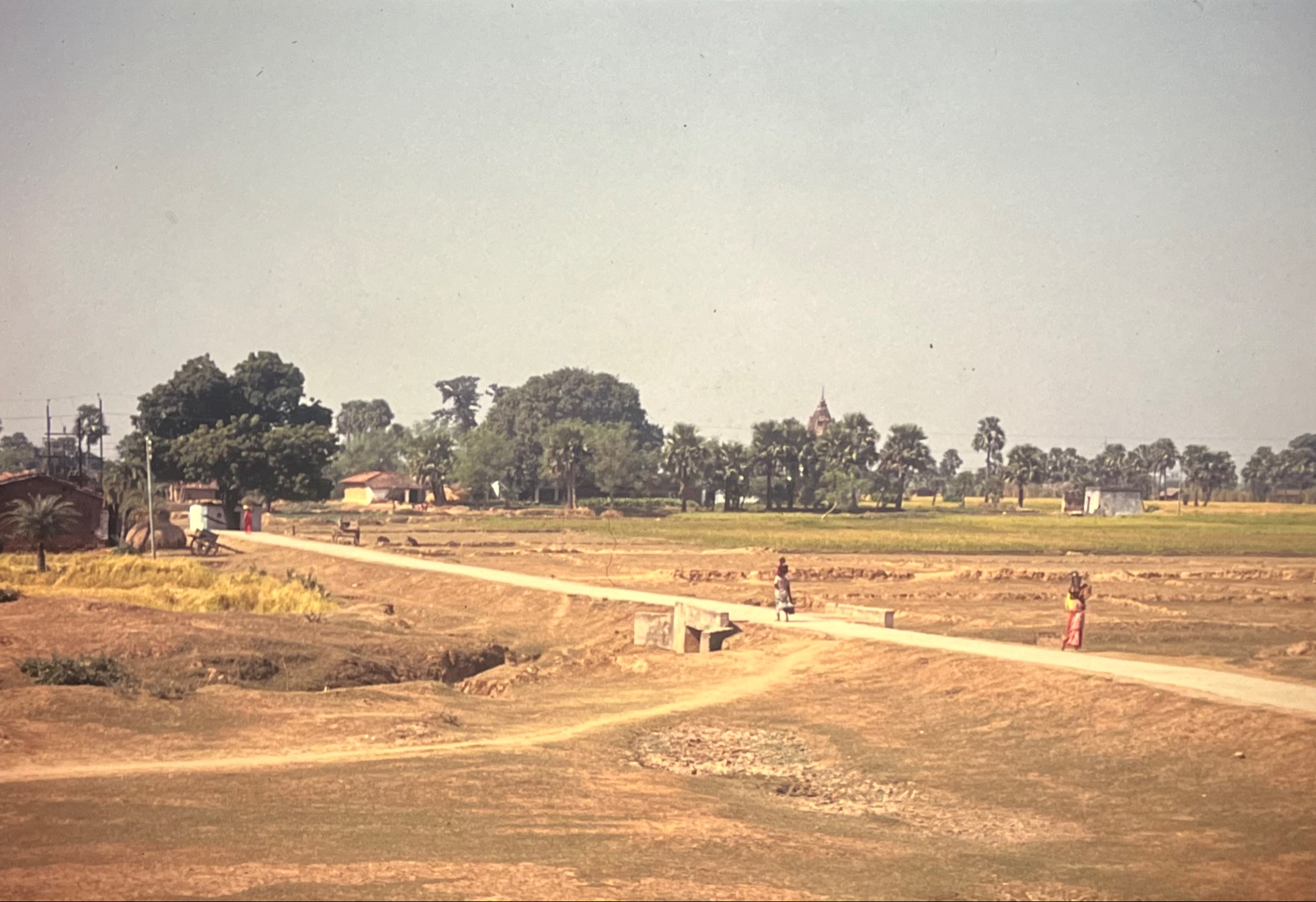
Arriving into Bodhgaya with the top of the Mahabodhi Temple peeking above trees
One of the first things that we (myself and Ray, an American who I had met on the road and was currently traveling with) noticed on arrival in Bodhgaya was the number of people who walking around with patches over one eye. Clean white patches. It wasn’t just one or two, there were a lot of people with patches. There were crowds queuing for food and others just hanging around, waiting for something, but at that stage, I knew not what?
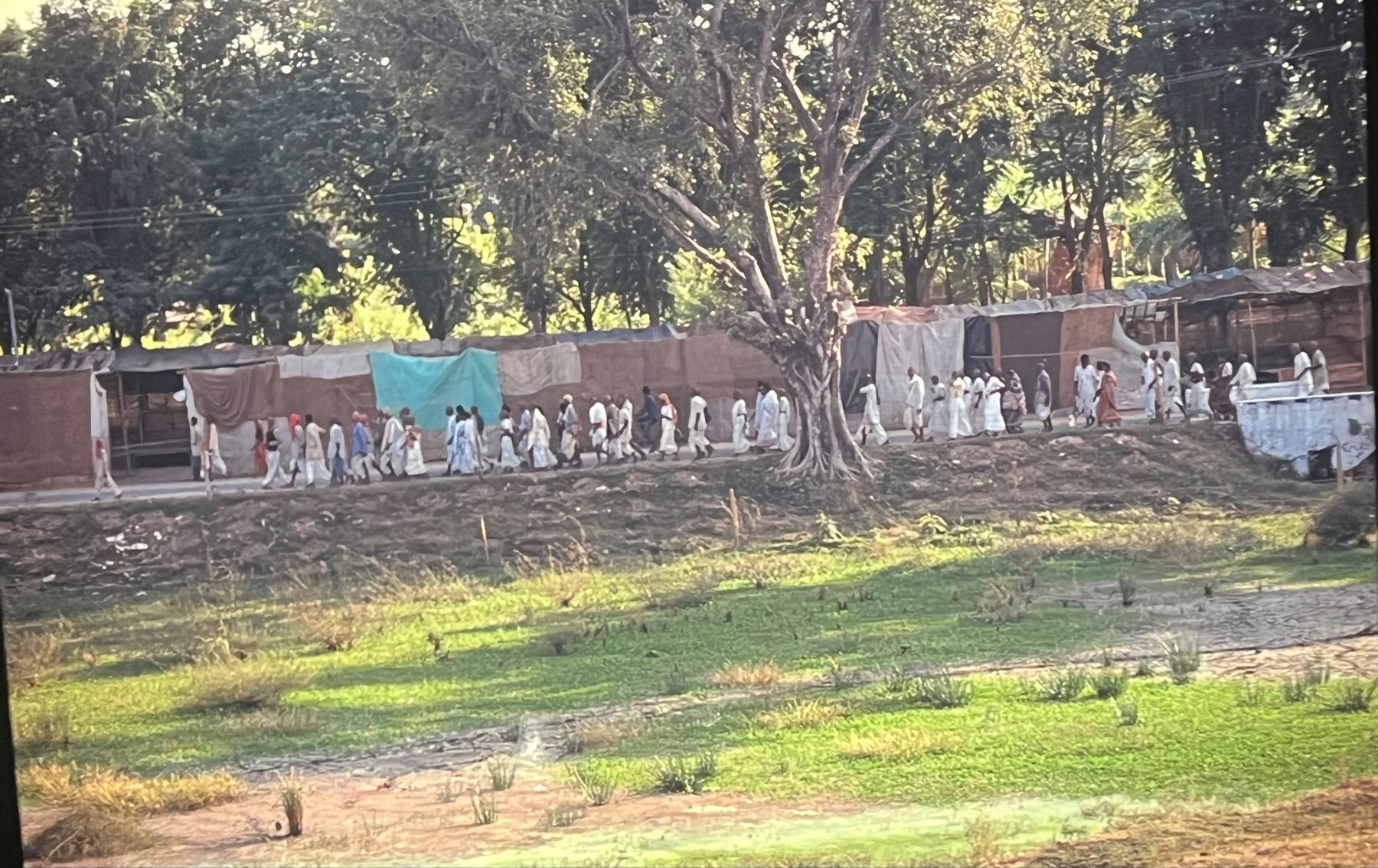
A group of people walking past some covered, makeshift stalls
Once we were settled in our hotel, I went off for a wander around by myself. I stopped in a restaurant for something to eat and then went to take a look behind the Tibetan monastery. Each Buddhist nation has a monastery in Bodhgaya. Behind the Tibetan monastery there was a building which appeared to offer rooms for the lay Tibetans and other hill peoples. I felt a visceral buzz to be around these mountain people again, following my time trekking in Nepal.
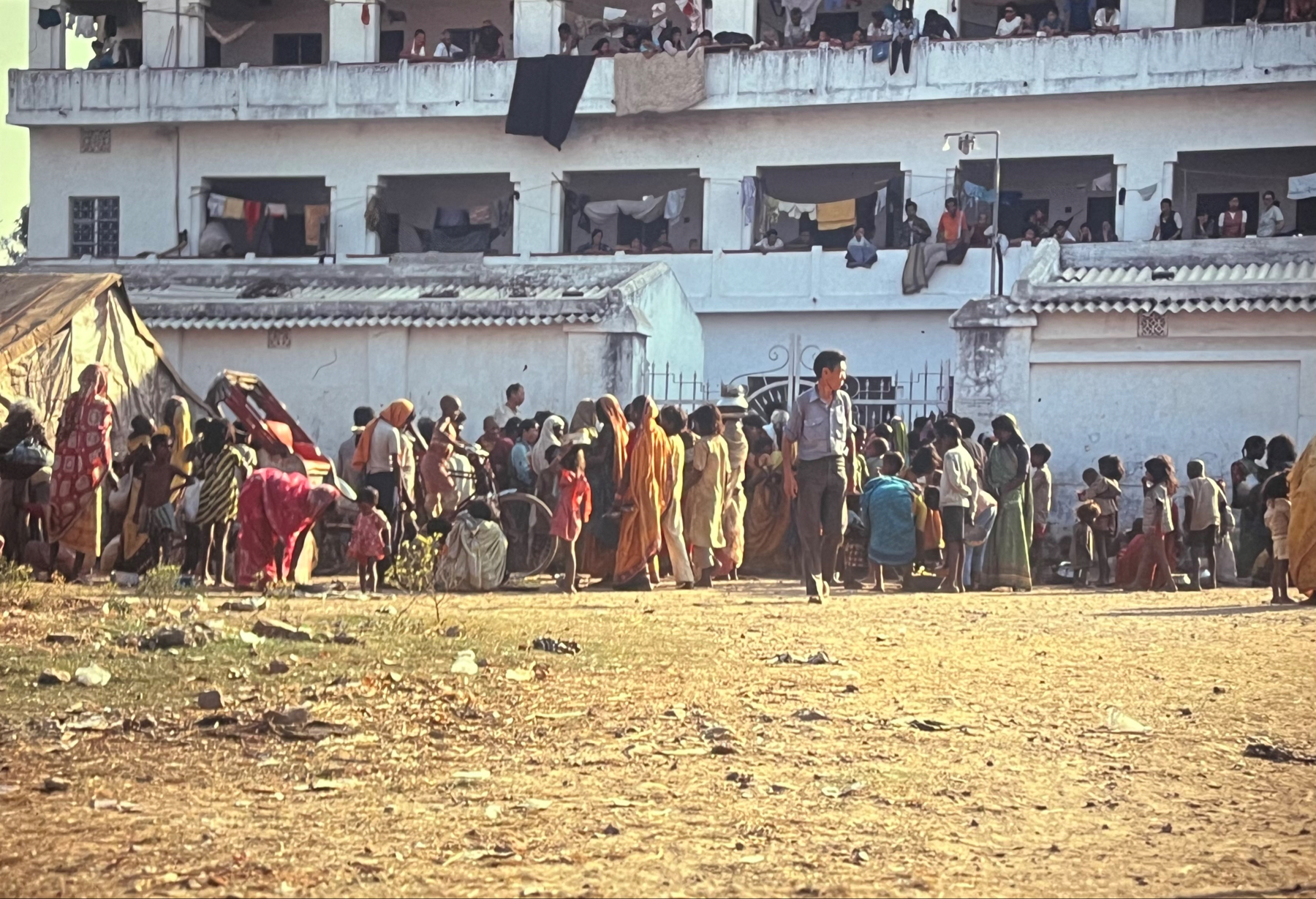
Crowds gathering in front of a building housing Tibetan people
I found out that a wealthy Indian businessman or men had paid for eye operations to be performed here in Bodhgaya. Apparently ten doctors were performing five to six hundred operations a day.That seems like a lot, but that is what I was told. His Holiness the Dalai Lama had offered the temple which was built for the Kalachakra Initiation in 1985 as an operating theatre for the doctors. Masses of tent like structures made up of bamboo frames covered by cloth surrounded the temple. The scene reminded me of what I had seen of refugee camps on television.
In front of the home for lay Tibetans were people waiting for food or to be operated on. I sat at a distance and as I started to blend into the background, took some pictures of the waiting people, and the food preparation.
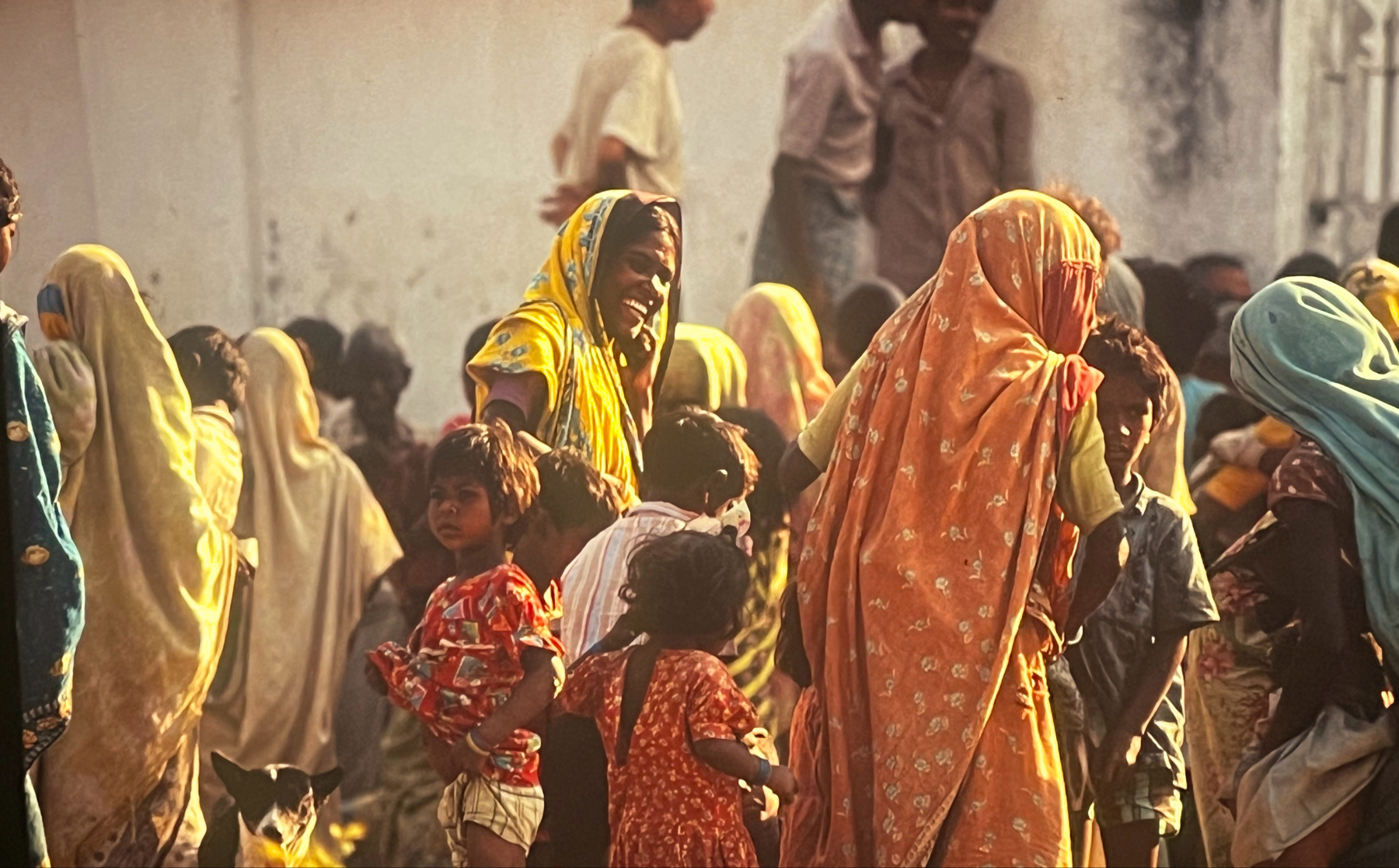
Crowds gathering
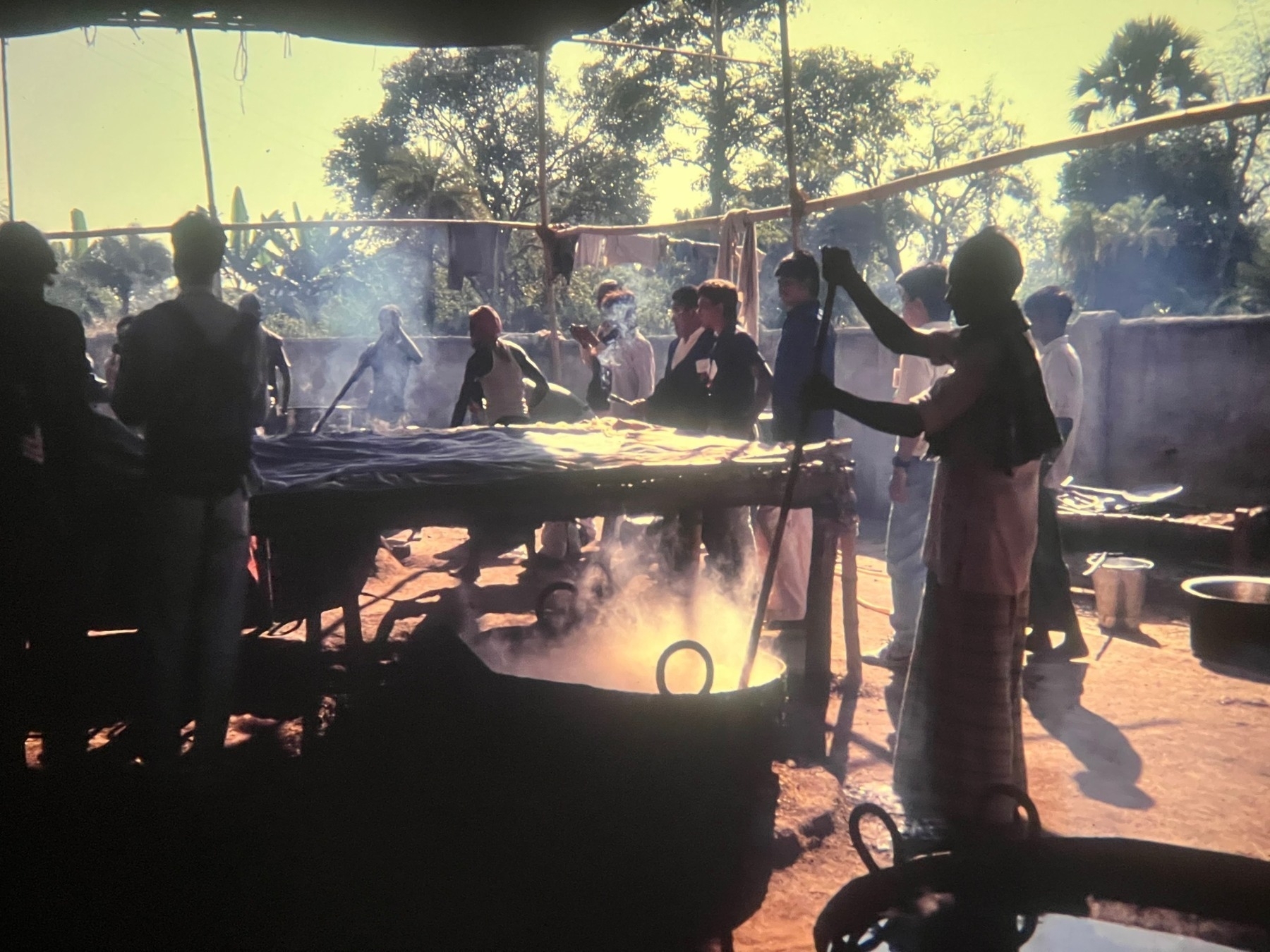
Food preparation
I started walking back to the hotel, passing a temporary and colourful archway with Tibetan people gathered around. I stopped to watch what was going on, not really wanting to leave. One monk had a sizable video camera on his shoulder. I got talking to a man from Darjeeling, Tamsin, who told me that the people gathered here worked in the handicraft stalls around Bodhgaya. They had closed up shop for a week in celebration of His Holiness the Dalai Lama having just been awarded the Noble Peace Prize.

Monk with video camera
Tamsin told me that they were all off to dance and invited me along. I followed everyone to a field just behind the Mahabodhi Temple which is built on the sight commemorating where Buddha attained Enlightenment. I just appeared to be accepted. No questions. I just joined them.
On reaching the field a circle was formed, half with the women linking arms together and the other half the men together. Singing started, dancing as well - stamping of the feet while slowly moving backwards and forwards. While I had no idea what was being sung, I didn’t and don’t speak Tibetan, there was something deeply familiar to me about what I was joining in with. I was familiar with the moves. I was not one of these people but I felt at home around them and very comfortable. The joy of this crowd of people was infectious. I was so happy. I wrote in my journal,
I sat down to watch the other dances. We got together for a group video shot. Tamsin took a photo of me, I one of him, a couple of Tibetans jumped. Everyone was smiling/laughing, just so happy. Writing this I wish that it was happening now. A woman started started singing, competing with some far off speaker. People listened and then joined in then clapped, laughed, smiled.
I stayed there until dusk. I had to get back to the hotel and look for Ray. What a day it had been. When I left home a little over four months ago I had little idea really of what the reason was behind my trip. There was a pull to see Central Asia and the Himalayas, I wanted to set off on this journey, but if you had asked me to explain the “Why?" of the trip, I don’t believe that I could have named it. Now I was starting to feel as though I was coming home (this I write on the back of a few other experiences that I had had earlier on in my travels, while in China, Tibet and Nepal). The sense of uncertainty of direction was going, replaced by focus and clarity. A murky clarity, but it was there.
I went to bed that night reflecting on how today had turned out. I was happy and looking forward to what would happen next. Tomorrow was the blessing of the new Buddha statue at the Japanese temple by His Holiness the Dalai Lama.
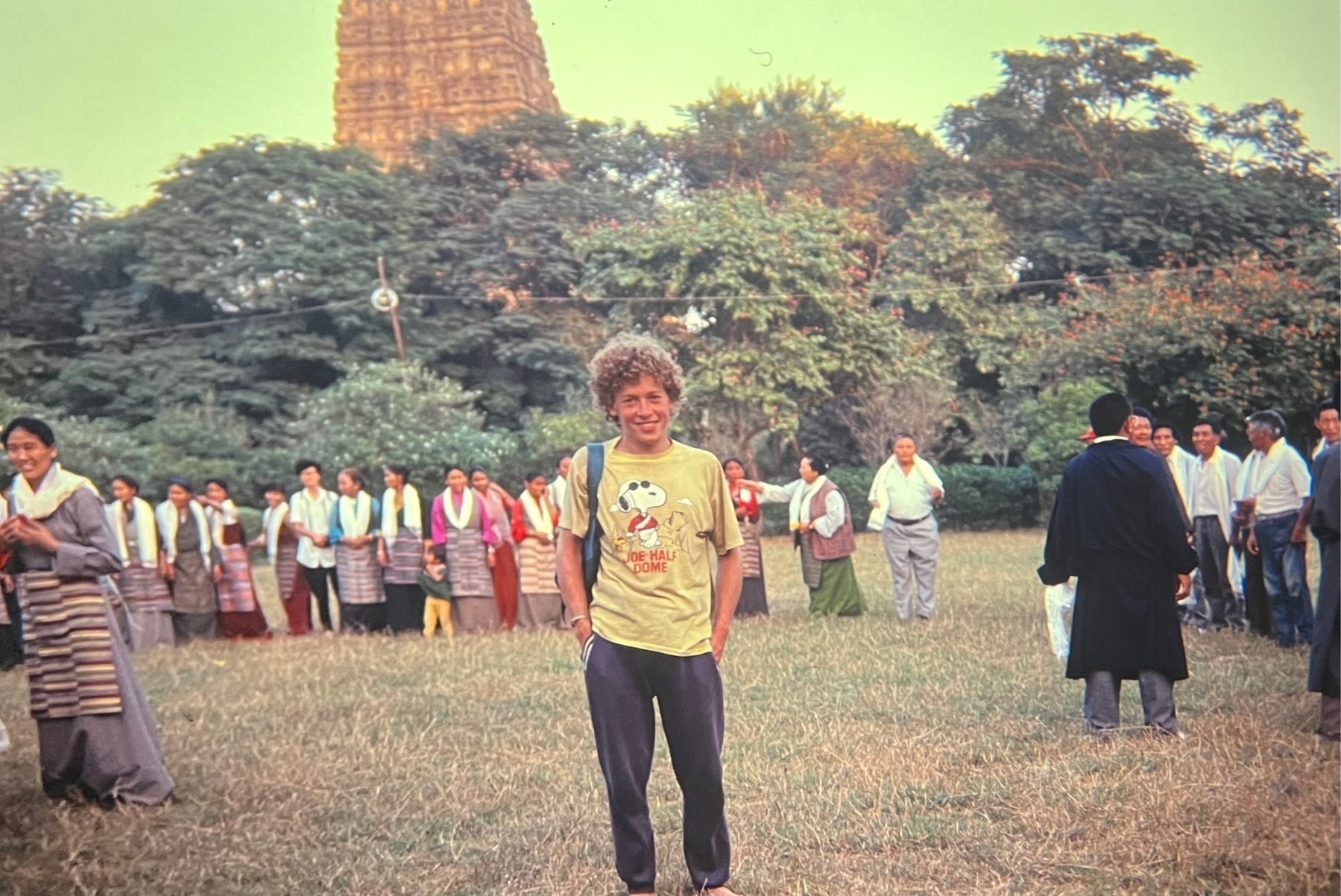
Me with the Tibetans after dancing
How I'm Capturing the Photographs for the Travel Stories
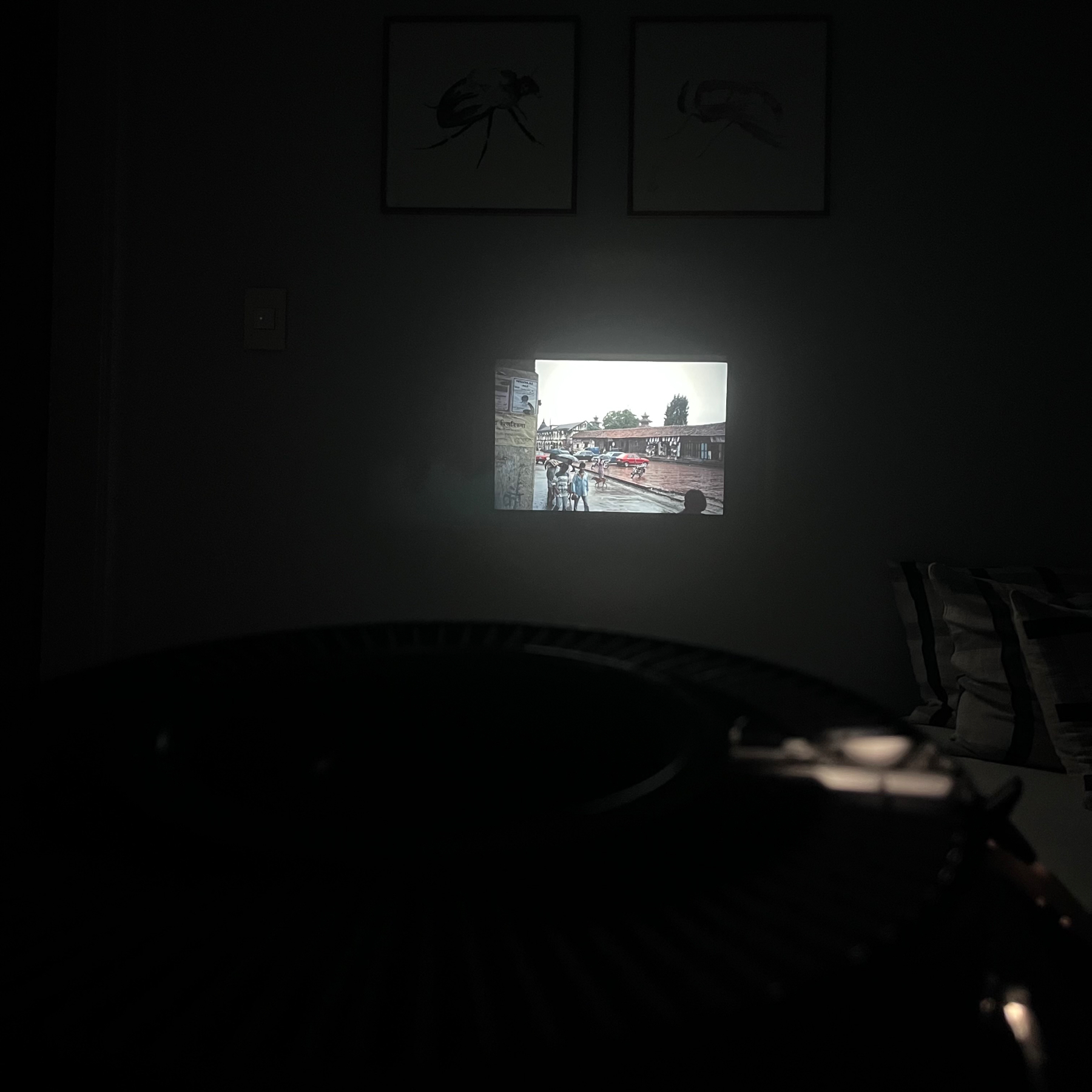
A slide being projected onto a wall in a darkened room.
When I set off on my travels in the mid 1980’s, I took a SLR camera with me. From my memory I had two lenses, a 35mm and a zoom lens the size of which I cannot remember. I believe that I also had a couple of filters with me. I did not know a lot about photography, though had been reading a little on the subject, and wanted to take the best photos that I could to remember and give me a flavour of my time away.
I decided to take slide film, though I cannot remember what drove that decision? Based on my reading, the film that I decided to take with me was Kodachrome 64. The price of purchasing the film also included the developing of it by Kodak. When you bought a roll of film, they provided you with an envelope with which to return the exposed film to Kodak for processing. I purchased a number of rolls and they were going to last me for the time that I was away. I had no idea if film would be available where I was travelling to, and so I left home with the understanding that what I took with me had to last the entire trip. So I had to make sure that I had enough film and at the same time did not get carried away snapping shots. I was not travelling with the largest backpack.
Again from my memory, I carried these films around with me for all the time that I was away. In the case of the images that I have shown here to date, that was a year long trip. Once I was back home I mailed them all off to Kodak to be developed, and thankfully they survived the trip in one piece.

A bustling train station somewhere in India, taken from the door of a train.
Now that I am revisiting those years on the road, I needed some way to get them from slide into my digital world. I believe that there are some services out there that will digitize your analogue images, but this wasn’t going to work for me, at least not right now. My slides are in a mess, there are a lot of them, and so I am working my way through them in a rather hit and miss manner. And I want them now, so that I can write as I come across images. Digitization might come in time, but not yet. So here is plan B.
Plan B
Plan B happened by accident. One evening I set some of my slides in a carousel and loaded them into my projector. In a darkened room my wife, Melissa, and I sat down to look at the images, for me to be reminded of places that I had forgotten about, and for Melissa to see where I travelled to during my earlier years. While we were watching them, Melissa liked some of the images so much that she used her phone to capture what we were looking at.
Bingo!
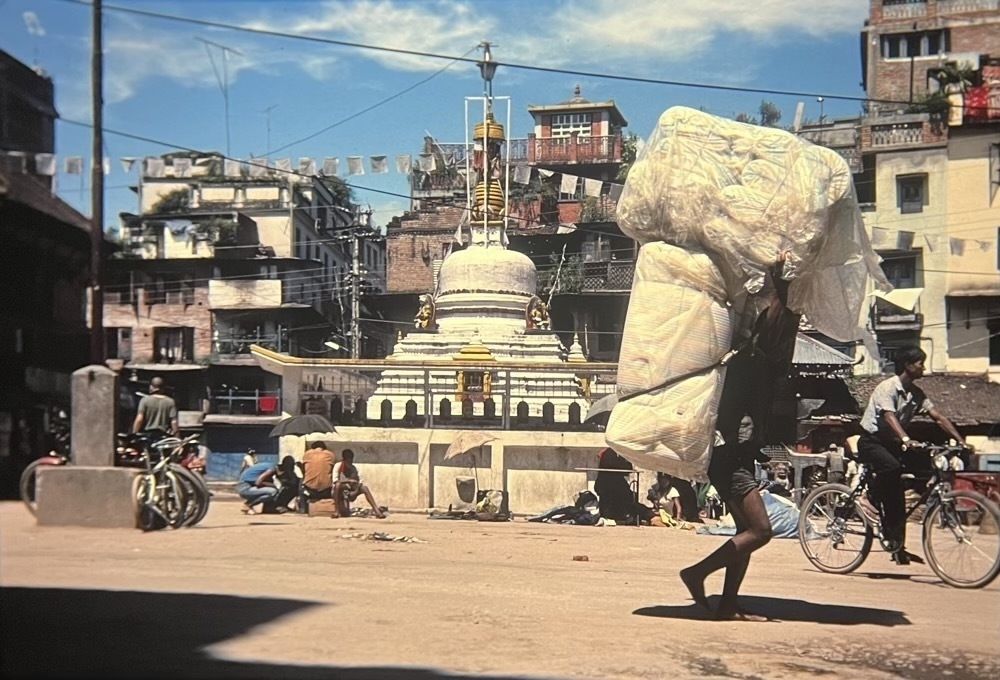
A small square in Kathmandu. The porters could carry impossible loads.
I now had a way of getting the photos from analogue to digital. I initially did some colour editing of the phone captured images, but did not like the results. So now I just leave them, just editing to straighten the images as they are captured at an angle to the wall projection to avoid shadows creeping onto the images from the projector light. The result might not be as good as a scanned, digitized image, but with the quality of phone cameras these days, I am more than happy with the result; the slightly vintage, aged look lending a mood to the photos.
And perhaps most important for me are the memories that these images invoke. I am returning to them after a period of almost thirty five years.

A tourist consulting a book with an Indian policeman.
The Story Behind the Photograph: From the Roof of a Bus
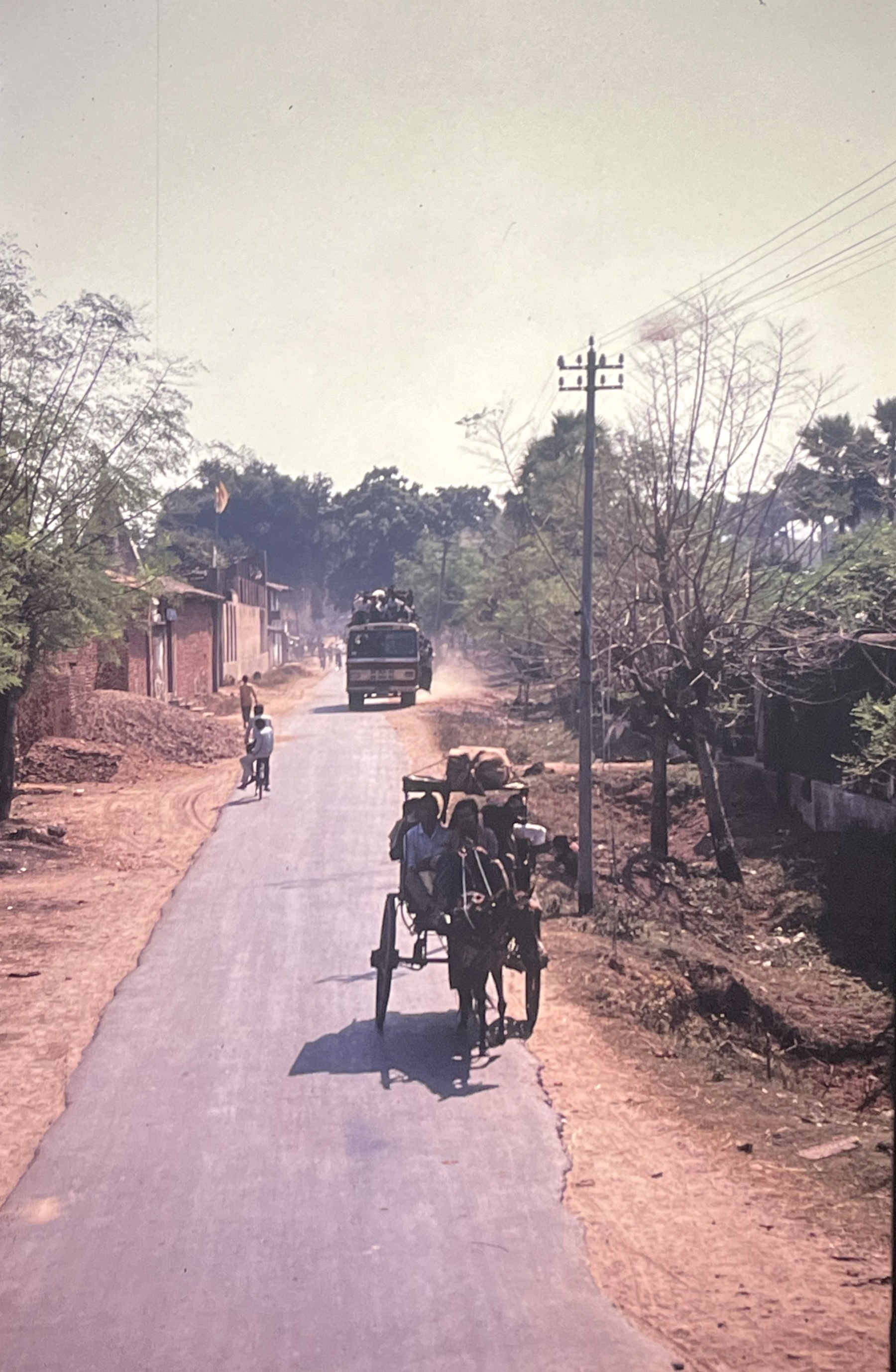
Road from Gaya to Bodhgaya from the roof of a bus
Following my time in Patna, I continued my journey onto Bodhgaya by catching a train to the city of Gaya. I travelled to Gaya by train along with an American, Ray, whom I had met in Patna. I had an omelette for breakfast in my hotel room, settled up with the hotel owner and then caught a rickshaw along with Ray to the railway station. There was a lot of misunderstanding between us and the rickshaw driver, and when we settled up on arrival we weren’t sure if his annoyance was because we’d paid too little, or if it was a show to get some more money? We chose to leave things as they were. I went to buy a newspaper to read on the journey and then went to find our train and carriage. On reaching our second class seats there was still plenty of room on board. However, the train soon filled up and by the time that we were underway seating became tight and squashed even though we thought that the express train that we were on would negate that experience. This was our first Indian train and we were still learning.
Seated, I picked up the newspaper that I had bought earlier. I had a quick flick through it and passed it onto Ray, not engaging much with the stories. Ray quickly passed it back to me, pointing out the article below.
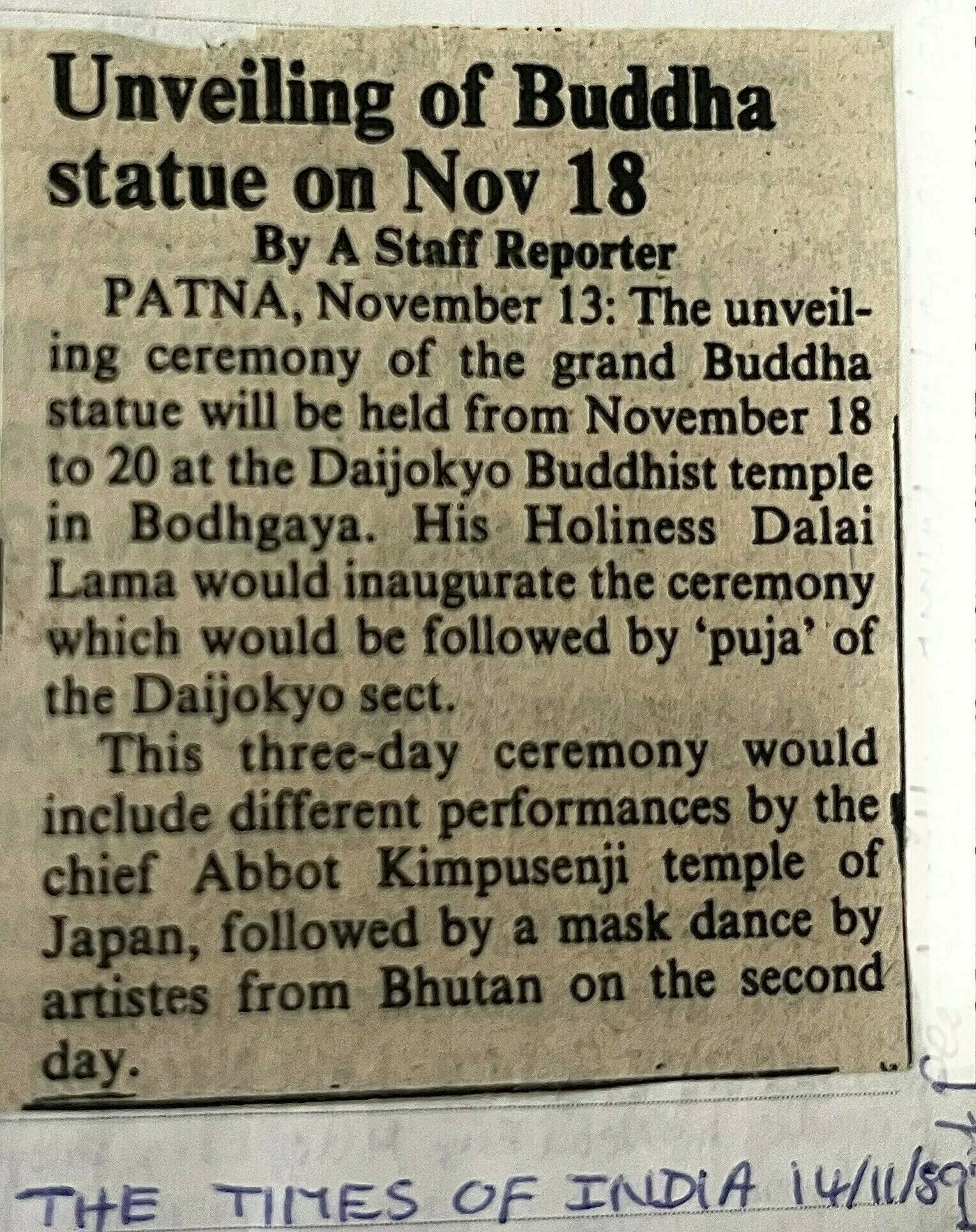
I couldn’t believe it. Just to say that at that time I didn’t really know who the Dalai Lama was. I was aware of his existence, but that was about it. And this was 1989. He wasn’t the world figure that he is today. Subsequently, people who I met who had been around him for a number of years prior said that 1989 was the year that things changed for His Holiness. That was the year that he was awarded the Nobel Peace Prize and really came to the world’s attention.
All of this aside, I was still excited. I had an unexpected but growing interest in Buddhism, was traveling to Bodhgaya because of this (I did not know of the village’s existence when I left home just over four months earlier), and now I find out that the Dalai Lama would be there at the same time that I was visiting.
We spent a day in Gaya, just exploring the streets making up the city. As in Patna we encountered demonstrations related to the upcoming elections. Nothing to disrupt our day, but another presence in the town. I had read and noted in my journal that Gaya,
is 2nd only to Varanasi in its sanctity.
Here is what I wrote about some of those wanderings.
We headed off through the crowded shopping streets, street vendors selling peanuts, fruits and a few other concoctions. We disappeared down some further backstreets, finding ourselves staired [sic] at a lot. We passed what appeared to be a loading bay for sacks of this and that. Back streets were filthy, really dirty. Stagnant black, scummy water in open drains. Piles of rubbish, there is one across the road from the hotel which the cows make good use of. Muddy streets, black mud, and ponds lying in the middle of the road. Rickshaws go by ringing bells, bicycles go by ringing bells, scouters go by making rasping noises with horns, autorickshaws, later in the day heat & dust.
We found the Vishnupad Mandir on the banks of the Phalgu River on which Gaya itself also sits. Not being Hindus, we were not allowed in the temple, but that did not matter. Gaya was offering us a lot to take in as it was. The river itself was more like a series of smaller rivers right now. There were people down by the river washing clothes, hanging around or making their way across. Dogs and cows joined them.
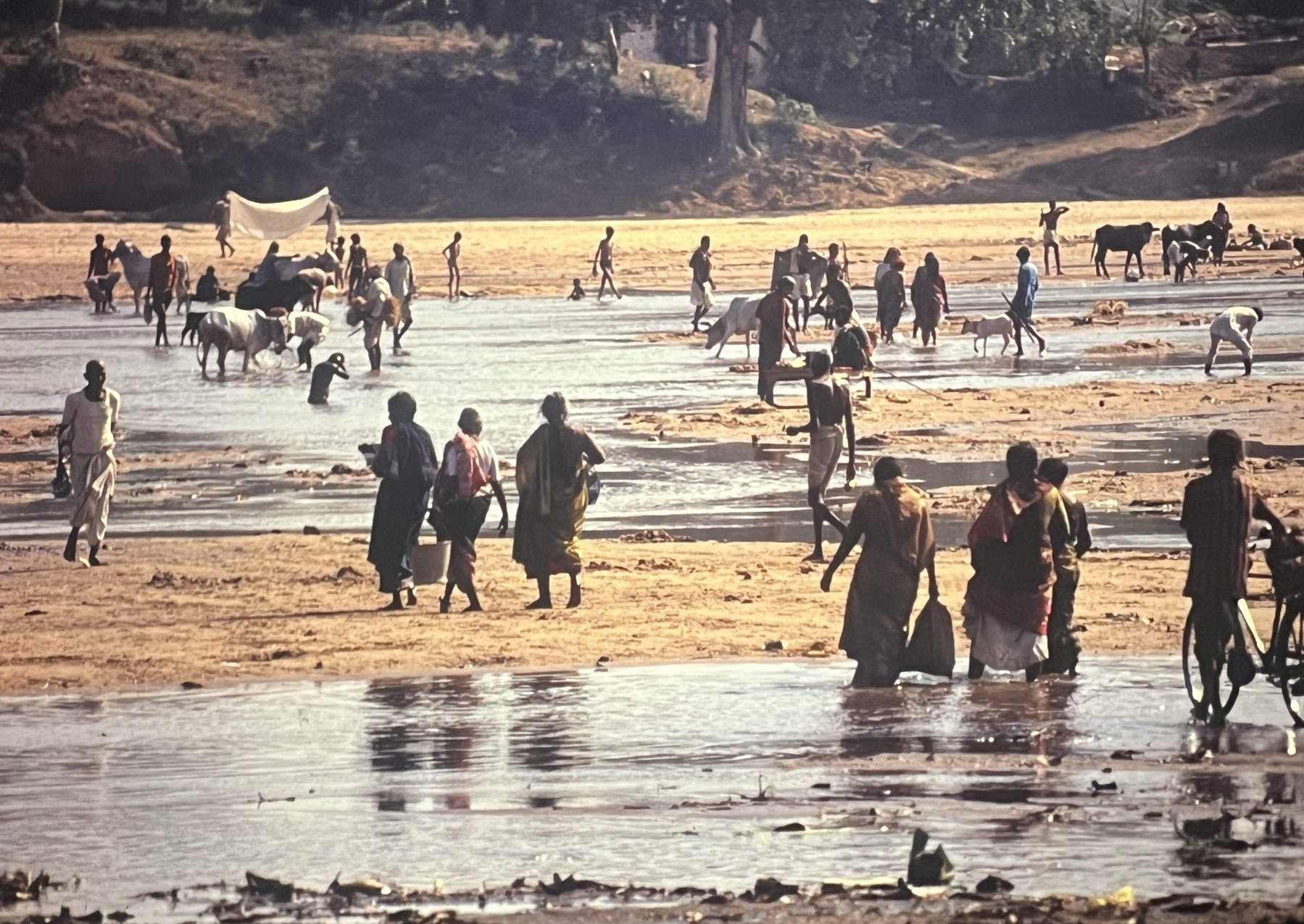
The Phalgu River in Gaya
Ray and I found a chai store where we sat down to eat, drink and watch life go by - a favourite occupation of mine.
The next day we travelled south to Bodhgaya. Rickshaw drivers and private vehicle owners tried to tempt us with rides for the 13km journey to Gaya, but we opted for the cheapest option - a Rs1.50 bus journey and the subject matter of the photograph at the top of this piece. We sat on the the roof to enjoy the journey and better see the environment that we were passing through. Leaving Gaya we had to be careful of low hanging power cables, but once out of town that was no longer a bother. Again, I’ll let my journal tell the tale,
…through flat agricultural land, small temples here and there, horse carts, autorickshaws, buses, horns honking. On our left was the dried up River Phalgu.
Arriving in Bodhgaya we had a chai before going off looking for accommodation. I scouted while Ray watched our backpacks. Finally housed in a hotel we went off to take a look around the village and see what Bodhgaya had install for us.
A Memory
I’ve just left Mahatma Gandhi’s ashram situated just outside of the small town of Sevagram in almost the geographical center of India. I had spent a couple of night’s at the ashram as part of a pilgrimage around India that I had set out on, to visit places connected with the life of Gandhi. He has been a big influence on my life, and I have read a lot by and about him.
I’m waiting at the railway station for a train, though I cannot remember my final destination. The station, from my memory, is simply one long platform. However, Wikipedia says the station is made up of five platforms. As I said, from my memory. Nothing else there. I am after all in the middle of nowhere. Maybe in the day it was a busy station as people made their way to visit Gandhi, but essentially this platform served a village. This was, now, not a major destination.
I arrive and sit on the platform floor to wait for my train. I have a few bananas with me that I bought on the way here.
After a while I am approached by two boys. One maybe pre-teen, another early/mid-teens. They start by asking me for money. I decided not to give them any change, instead I offered them a banana each - which they accepted. They joined me seated on the station platform. There was little to no language in common, but they somehow asked and I replied with my destination.
The time for the arrival of my train came and went. I don’t remember any announcements being made as trains intermittently came and went, but I really didn’t need that. My two companions appeared to know every train that passed through. Whenever a train came in site they would shake their head. I trusted them. I had no reason not to.
We sat there for a long while, from my memory, with animated (literally) banter in order to communicate. Eventually their shaking heads were replaced with a nod as the next train drew in. I thanked them both, said goodbye and hopped on the train.
I never forget that time at Sevagram Junction and my gratitude to those two boys.
The Story Behind the Photograph: A View Over the River Ganges

Photo of a slide projected onto a wall.
It was mid November, 1989. I was four months into my journey through Central Asia. With my visa expiring, my time in Nepal was drawing to a close. Not feeling ready to go home, indeed a deeper sense of purpose and exploration beginning to arise from the trip thus far, I decided to travel down to India. I had left home with a few vague goals of things that I wanted to see or do, otherwise I was following my nose and seeing where the adventures would take me. During my travels to date I had experienced a deepening interest in Buddhism, a story within itself, and because of that I decided to head to Bodhgaya the place of Buddha’s Enlightenment. I was in Kathmandu and Bodhgaya is essentially directly south of the city, albeit a journey in itself. The route that I took went this way,
Kathmandu -> Birgunj at the Nepalese/India border -> Patna -> Gaya -> Bodhgaya
This journey started with an overnight bus ride from Kathmandu to Birgunj at the Indian border. I arrived at the border in the early hours of the morning, 4:30am to be precise. The temperature was cool. Streets were quiet. A full moon shaped like a rugby ball as it hung low in the sky was turning orange. A lot of rickshaws and donkey carts waited around.
I caught a rickshaw and headed towards the border, however I’m not sure that it was the 4km as the driver claimed!
From my memory the immigration and customs process on the Nepalese side was smooth and friendly, the Indian side was completely the opposite. I felt as though the officials were holding it against me to have them up at this unearthly hour…possibly a valid complaint?! From my journal,
Nepal immigration was friendly, let me keep my trekking permit as a souvenir, and as I left said “see you again.” … Then Indian customs; unfriendly, short curt questions, at least he didn’t waste time emptying my pack. Immigration was equally unfriendly, but at least there was a smile out of the guy halfway through the proceedings. He spent a while finishing some other paperwork…, ruled some lines in a book and then dealt with us; a Japanese couple as well. I had filled out my forms and sat there and watched him for a long time.
Once I was through all the red tape I went in search of the bus to Patna. Six hours later, and a couple of stops for chai on the way, the bus came to halt just short of Patna. It turned out to be a demonstration of some sort (I found out later that elections were happening, and this demonstration was related to them). Once we were underway again the bus crossed a long bridge spanning the River Ganges, on which Patna sits.
On arriving at the bus station I quickly found a rickshaw. I asked to be taken to a particular hotel that I had in mind to stay at, but the driver took me to different one. I didn’t know where I was and so I went in to see what I could make of this hotel. I managed to bargain down the price of the room and then the hotel owner took me out on his motorbike to look for a bank to change money - I had been in his country for less than a day. I don’t know why he did this though as it was a Sunday? Banks were closed. I would try again tomorrow.
The next morning the owner of the hotel woke me up, I assume by knocking on my door though I have no record as to his method. He asked me if I would like breakfast - tea and an omelette with toast. With food inside me I went downstairs to chat with him in his cloth shop before heading out to look for a bank. This is where the subject matter for the photograph started to emerge.
On stepping out of his shop I was immediately swept away by a mass of humanity. I was only going in one direction: where the the crowds, old and young, were going. The hotel owner had told me that today was the Hindu Festival, Kartika Purnima, and (as he wrote in my journal),
All people want to bathe in River Ganga.
Down by the river I climbed onto a wall. I shall allow my journal to explain the scene that I looked out on (the photograph can do the rest),
[The River Ganges] must be 3km wide at this point. The far bank was a mass of people, all sizes of boats were plying between the two shores, being rowed and laden with people. On my shore people were bathing in the Ganges, some fully clothed, men in loin cloths or mini sarongs.
And from my memory there was a haze in the air, a haze that in time I came to associate with India - dust driven up by the shear number of people and a mist from this time of year, Autumn slowly crossing into Winter.
In time I went on my way to find a bank and was able to change some travelers cheques. The remainder of the day I spent in Patna. I met an American who had been on the same bus as me from the Indian border and we agreed to travel down to Bodhgaya together. We ate lunch and stopped to watch a fortune teller who was using a bird to pick cards. That evening I returned to the Ganges. It was quieter now. Groups were gathered performing various rituals, symbols playing, incense burning, dancing. Some were cooking. A cremation was taking place to one side.
I returned to my hotel to sleep at the end of my first full day in India.
The Story Behind the Photo: A Bus Full of People

The original of this image was a slide. I projected it onto a wall and took this photo.
I initially posted this photo on September 3, 2023, but offered no context for it. Following the reception to my story about a photograph that I took of Mt.Everest at sunset and encouragement of Miraz and Maique, I have decided to revisit other photos that I have posted of my travels, as well as ones yet posted, and share their story. Retelling the story behind the Mt. Everest photograph took me back to a time in my life that was important to me, reshaped my life, and delving back through my journals deepened my memories of those journeys.
This story starts almost where the Mt. Everest photo left off. My trek to the Solo/Khumbu region of Nepal, where Mt. Everest sits, ended at the small village of Jiri. From there I had to catch a bus to Kathmandu, a day long journey. I had been out trekking for thirty days, and was sad to be leaving these mountains, though illness was calling for me to rest.
I arrived in Jiri on October 28, 1989, with my stomach feeling none too good. That night I had to make two runs to the toilet, explained in my journal as being made…
…none too easy by the fact that the toilet was a good 70m away outside and I had to get past 2 locked doors to get there.
As I read that entry, I could picture the battle to get to the toilet that night. I think that I had giardia due to the sulfurous burbs that were accompanying the upset stomach. Dirty water, or food were probable causes.
I was considering staying put in Jiri for another day just to rest, but sooner or later I would need medication to fight the bacteria in me, something that I was unlikely to find that in this village. The next morning I felt a definite improvement, skipped breakfast in order to give the bacteria nothing to feed off (and my body nothing to get rid of!), and an American couple gave me four tablets to “nuke it."
I got on the bus early, put my pack under the seat instead of on the roof as it had amongst other things the underdeveloped slides of the trek that I gratefully still have, this image being amongst them. However, by the time that the bus left I was feeling tired and nauseous, not helped by the man next to me smoking. Two hours into the bus ride, we stopped. I used the opportunity to grab my back and climb up onto the roof. Surrounded mainly by porters and a couple of westerners, I spent the rest of journey on the roof top. Again, I’ll share from my journal,
No rain, just sun, blue skies, a little wind and beautiful views. The Himalaya rose up abruptly behind terraced hills and lower lying cloud. Orange flowers decorated houses, dogs, cattle. People picked more <flowers> as today is the 2nd day of the festival marking the new year. I dozed for a while and marveled at the country side…
Along side the road chautara (or store rest stops) appear by paths. I wonder whether this is part of the old trail <coming all the way from Kathmandu> or just another trail between villages. Gaurishankar and the surrounding range become even more impressive than yesterday, rising up shear and dominating the skyline to the north.
On the way we passed a bus going in the opposite direction, the photo that is at the top of this piece. I did not record how the two buses past each other, but be sure that they did as I am writing this now!
The tablets that I was given in Jiri must have done their work, as I was feeling better by the time that we reached Kathmandu. The city was busier than when we left. Trekking season had arrived. I had picked just the right time to head up to the mountains. The hotel where I had left the rest of my gear, that which I didn’t need during the trek, was full. Despite the friendly staff, I was silently happy that I could not stay there as the area surrounding the hotel was now busy and noisier than before. I repacked everything and headed across town to find a quieter hotel.
That evening, with a settled stomach and having not eaten all day, I had some dinner and then headed to bed for a good night’s rest.
The Story Behind the Mt Everest Photograph
Yesterday I posted a photograph showing the last rays of sunlight catching the summit of Mt Everest at the end of a day. After putting it up online, I was reflecting on the story behind the image, and thought that I would share it.
The year was 1989, the month September. I found myself in Nepal at what turned out to be a little under halfway through a journey that would take me through Pakistan, China, Nepal and India. Plans for the trip were no more than a sketch. I had bought a one way ticket to Karachi in Pakistan, had a couple of destinations that I hoped to visit, but that was about it in terms of planning. It turned out that I visited most of those destinations, but plans also changed as I traveled, as events happened, and as I met people.
One of my pre depature hoped for destinations was Mt. Everest base camp. The reason was simple, because Mt. Everest is the highest point on this planet, and as climbing the mountain was not on my cards, base camp seemed to be the next best option. My interest in visiting Mt. Everest was also informed by having read the biographies of Chris Bonington, the British mountaineer who led pioneered expeditions to many of the Himalayan peaks.
I arrived in Nepal on September 20. A week later I had my trekking permit for the Solo/Khumbu region, where Mt. Everest sits. It is possible to fly into the region, cutting two weeks off of the trek, but I was in no hurry and I wanted to see Nepal. The great Himalayan peaks inform the geography and personality of the country, but the people make it. I want to see and meet the Nepalese people and understand those who lived in the shadows of these great mountains. Although I had left home by myself, on the day long bus ride to the trail head I met a handful of fellow western trekkers who became my partners for the next couple of weeks. We were blessed by a monsoon season ending early and there were very few other trekkers on the route. We had this corner of Nepal to ourselves.
Let me now fast forward to the photograph. This was taken about two weeks into us setting off. As we reached the higher elevations there was the necessity to slow down our height gain each day in order to acclimatize to the thinner atmosphere, and to keep altitude sickness at bay. By October 13 we were at Lobuche 16,210 ft (4,940 m). We had planned to spend a couple of nights there, but woke up on our first morning to extremely cold weather, a hard frost, some snow and a thick mist. Unsure what to do, we sat most of the day out. Very slowly the mist cleared and blue sky revealed the mountains of Nuptse, Pumori, and the Khumbu Glacier which comes down off the Everest massif. Mt. Everest itself is not visible at this point, despite us being so close to the mountain.
With the clearing weather we had an idea that went against all acclimatization recommendations. We would push for Gorak Shep at 16,942 ft (5,164 m), dump our backpacks in a hut there and climb Kala Patthar at 18,519 ft (5,644.5 m) for a sunset over Mt. Everest. And so off we went. At Gorak Shep we found a place to stay, got some warm noodles in us and then started up Kala Patthar. It was slow going. Now we could feel the elevation. A few steps and then rest. A few more steps, and rest again, panting for breath. …And then the clouds starting moving in. We did not know what to do. This was not a place to be caught out and although Gorak Shep was straight down the mountain that we were on, the diminishing visibility and increasing cold was telling us that we were not in the best situation. Our idea was not working out as hoped for.
Then it happened. Suddenly the cloud dropped beneath us, Mt. Everest came into view and there was that orange pyramid seen in the photograph, as the setting sun caught its peak. And at the same time an almost full moon rose from behind the mountain (I have not been able to find that photo). I wrote the following in my journal,
Then, just as we were about to head down the clouds dropped from beneath us and an almost full moon rose behind Everest. There we were for 5 minutes with the moon and the highest peaks in the world. Cameras whirled; absolutely fantastic!
That evening, that experience, has never left me.
The summit of Mt Everest, peeking out from behind surrounding mountains, coloured orange as it catches the last rays of sunlight at the end of the day. This image was captured during a month long trek to the Solo/Khumbu region of Nepal around September 1989. Photo of slide projected onto a wall.
